CRITTERS
AT BRAZOS BEND STATE PARK Page 7--MAMMALS
This
page was born 02/19/2007. Rickubis designed it. (such as
it
is.) Last update: 09/27/2024
Images
and contents on this page copyright ©2002-2024 Richard M. Dashnau
Go back to my
home page, Welcome
to rickubis.com
Go
back to the RICKUBISCAM
page.
----------------------------------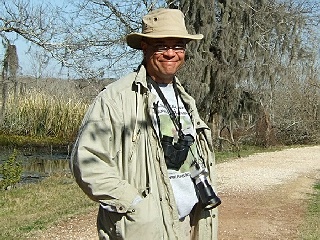
That's
me on the 40-Acre Lake Trail at Brazos Bend State Park
(12/31/2007). I
was waiting for an otter to show up. It didn't.
As
I get pictures of other mammals at the park (and elsewhere),
I'll be putting
them here--except for Otters. They have their own page.
05/04/2024 At BBSP (which was celebrating its
40-year anniversary). A Swamp Rabbit (Sylvilagus
aquaticus, as far
as I can tell) ate quietly at the edge of
the 40-Acre lake trail. ( picture 1) The remaining pictures are of 2
relaxed rabbits I encountered on the Spillway Trail a bit
East of the Spillway Bridge. The differences between
a Swamp Rabbit and a Cottontail are hard for me to see,
so I could be wrong about which rabbits they are. I'm also a
bit curious about what put those notches in the ears of
the rabbit in picture 1.
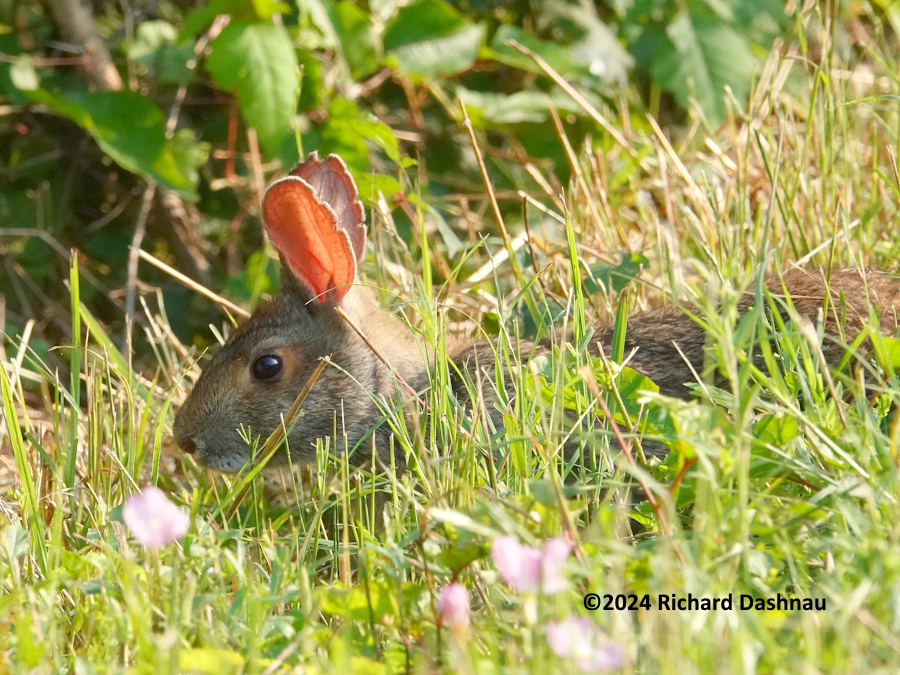
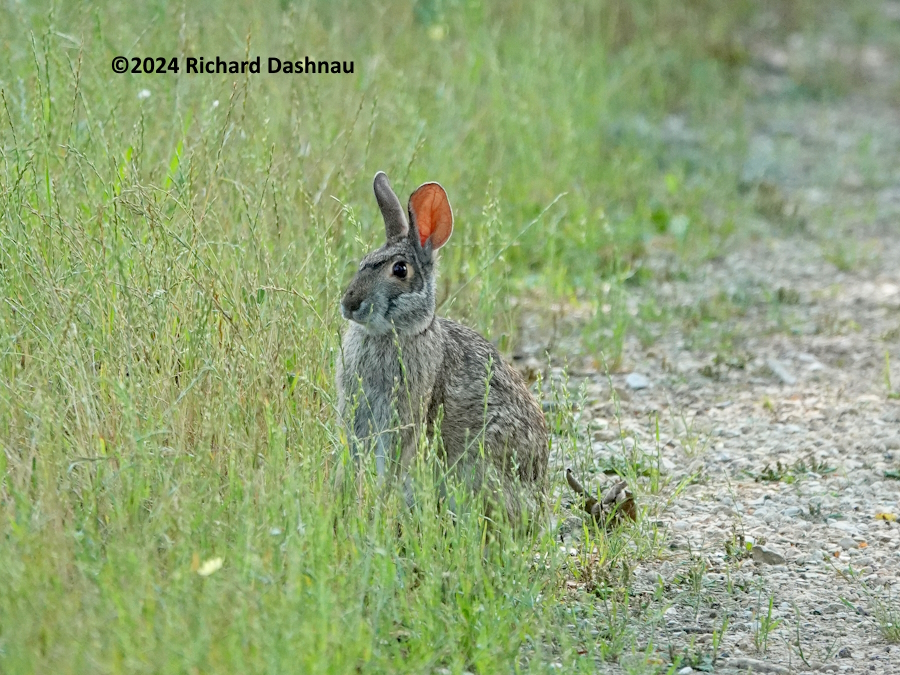

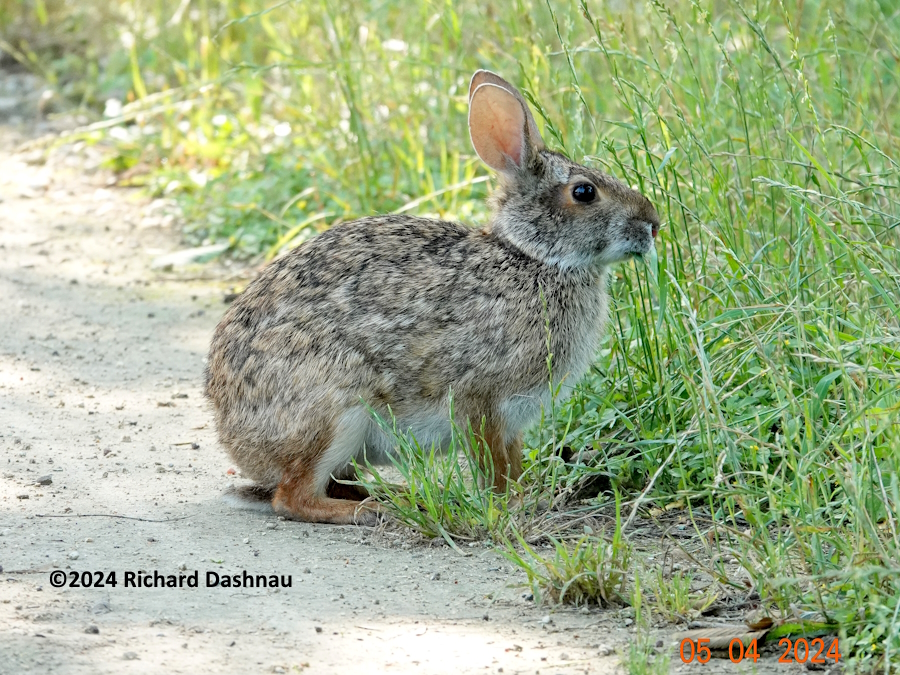
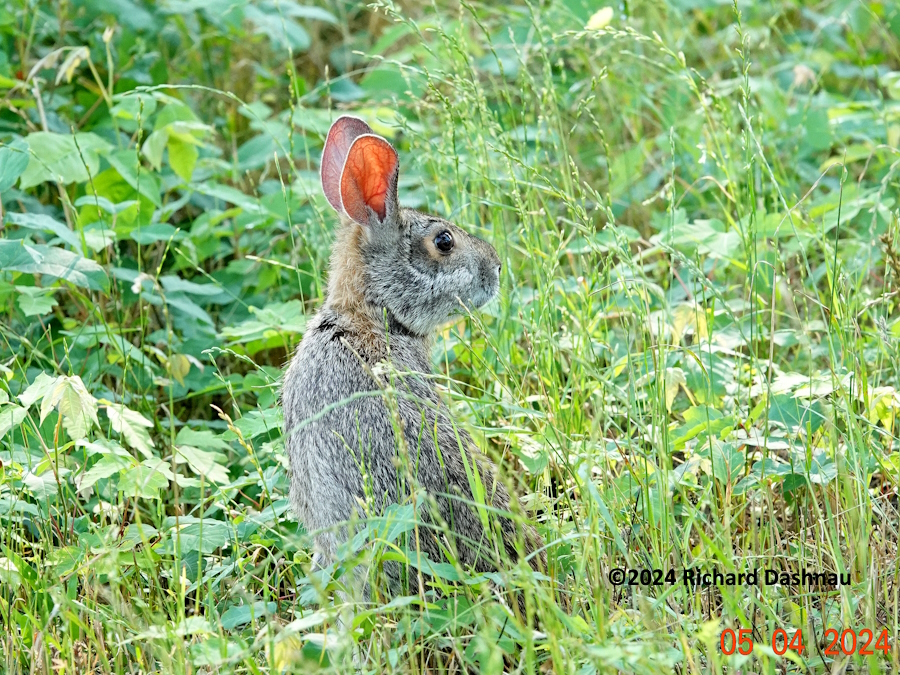
The
morning was partially cloudy, and I thought that at first that at
least one of the rabbits had a bare patch on its face. The rabbits
were eating on both sides of the trail. As
they kept crossing back-and-forth, I couldn't tell them apart. When
I took a closer look, I saw that the rabbits' facial fur had an odd
pattern, giving me the illusion of baldness.

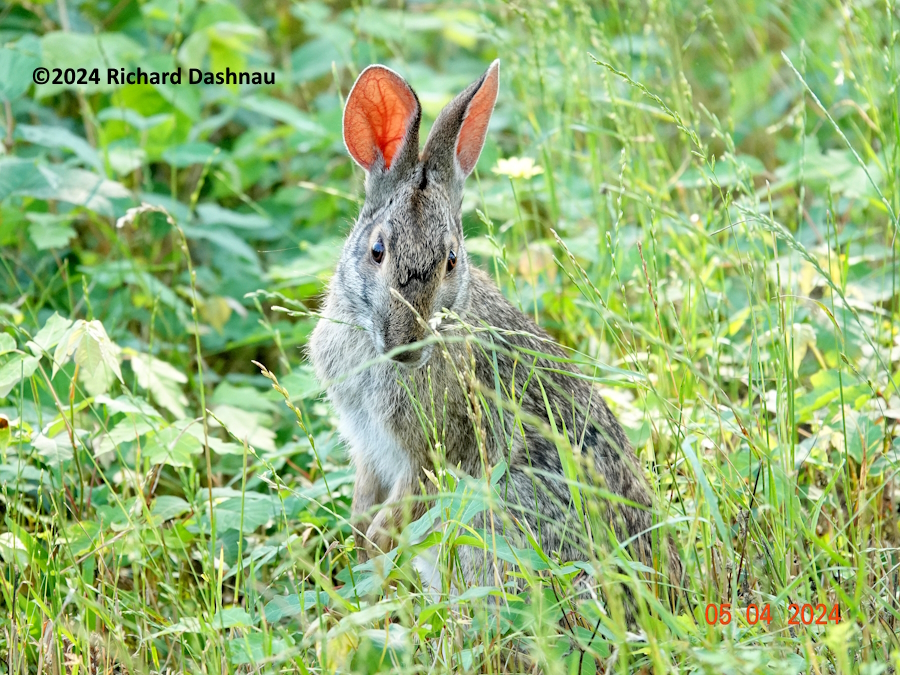
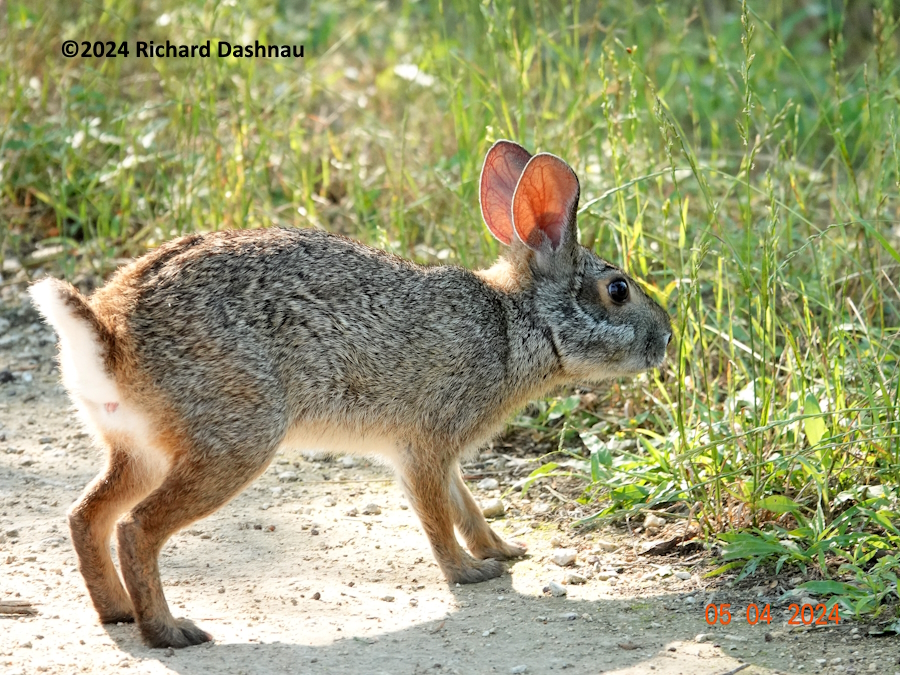
On
the morning of July 16, 2023,
I
was moving North on the East loop of the 40-Acre Lake trail (the
North
loop was closed off because of alligator nest activity.)
Near the middle of that section, this rabbit moved onto the
trail
from the right and began eating. I didn't want to interrupt its
breakfast, so I paused for a while to
watch. The rabbit
was also in front of one of our "alligator warning" signs, so I
carefully moved enough to get an angle that would allow me to
capture
that rabbit and the
sign in the same image. These pictures were the
best I could do.




I'm
sharing the series because it appeared that the rabbit "noticed"
the
sign, and decided to read it by the last image. Did the
rabbit
read the sign and think "Since I'm
not a dog, I can go where
I want."? Or was the rabbit wondering how if it would be able to
keep
its dog on the trail after that experience last time when
the
dog
slipped the
leash and made all that trouble. I have no idea
what kind of dog a rabbit would keep, but that's their problem. I
can
say that I haven't seen any rabbits walking dogs on the
trails since those signs have appeared (and even before
the signs have appeared).




I
believe this is a Swamp Rabbit (Sylvilagus aquaticus) and not an
Eastern Cottontail (Sylvilagus floridanus). Ever since I
first
encountered the
name "Swamp Rabbit" I've
wondered a bit about why it's not a
"Cottontail". So I looked it up. Swamp Rabbits and
Eastern
Cottontails are in the same genus: Sylvilagus-Cottontail
Rabbits.
Besides
living in swamps (ha, ha), Swamp Rabbits are larger than Eastern
Cottontails (which also live in Texas). From the descriptions I've
found, Swamp Rabbits' fur has
more black and brown colors than
Eastern Cottontails, and a "cinnamon colored ring" around the
eye.
Eastern Cottontails have longer ears than Swamp Rabbits and
possibly
a different head profile. I believe the rabbit on the trail was a
Swamp
Rabbit. Many sources described their ability to swim, but I
haven't
been able to see that. I
included the first image to also show how
much the appearance of the 40-Acre Lake Trail has changed
during
these months of low water(since last year!). I was half way
up that loop, looking Northwest at the lake in the first
image.
On 11/26/2021;
I was at Russ Pitman park. Squirrels were active all
around me.
I see squirrels almost everywhere, and their antics
and calls
don't usually capture
my
attention for very long. But today, I watched them running
up and down
tree trunks; up, down, and along branches. And then I
noticed that they
seemed to be running
on the bottom of
horizontal
branches!
Along with that, they were also running in "corkscrew" paths
along horizontal and vertical branches. They were running on the outside
of
these surfaces. Running, or bounding--
feet
leaving the surface, with little or no contact with the
surfaces they
were moving along; in all directions. I decided to try to
capture some
of this movement with high-framerate video. I was
able to
catch
some of this activity at 240 fps (usually I try for 480
fps...but I
hadn't reset the camera). The images below show just
one example
from the video--but in this example the
squirrel
had run under a
branch, and temporarily lost contact with all four paws. It
quickly
recovered, as shown in the sequence. The entire edited video is here
2min, mp4. Squirrel Parkour!!
I'll
try to capture more of this squirrel acrobatics. By
the way, both
Gray Squirrels (Sciurus carolinensis) and Fox Squirrels
(Sciurus niger)
were running around that day. The videos show
Gray
Squirrels in
action. The white fur on the undersides (and white spots by
the ears)
help with this I.D. Fox squirrels have orange fur on
belly, and
mixed in a bit with the upper gray.
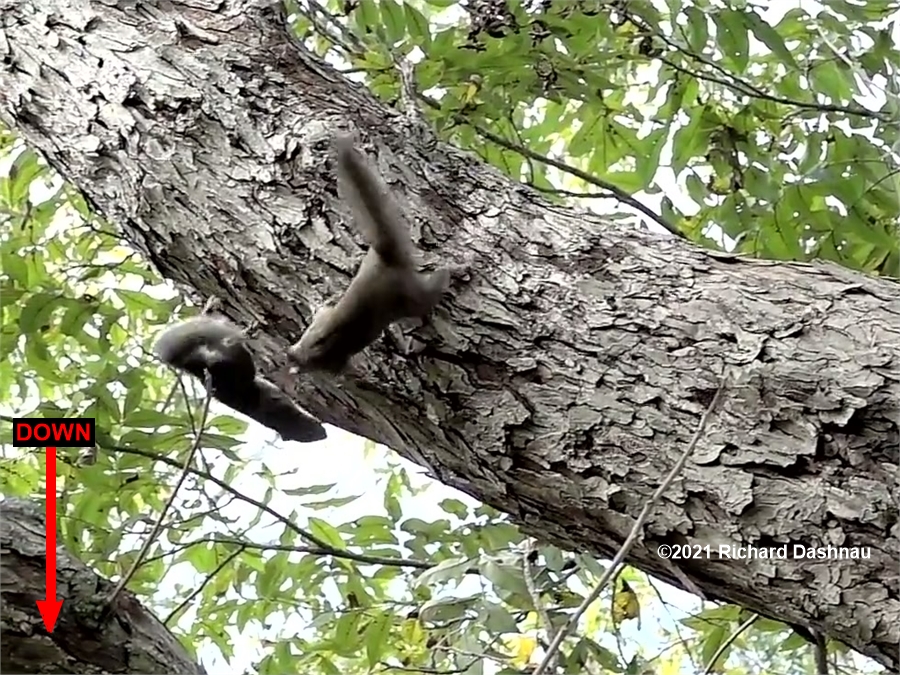
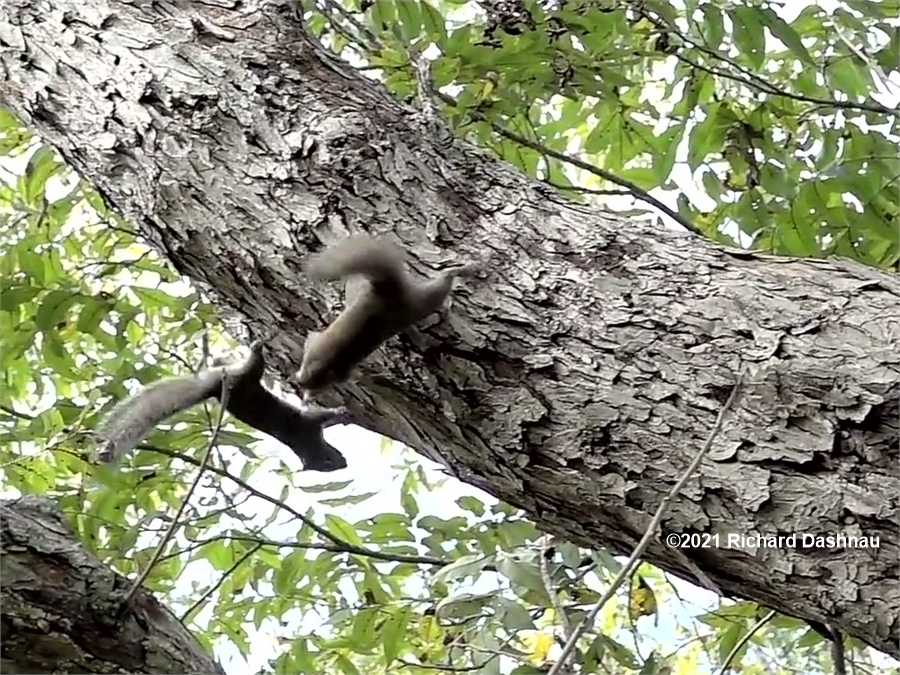
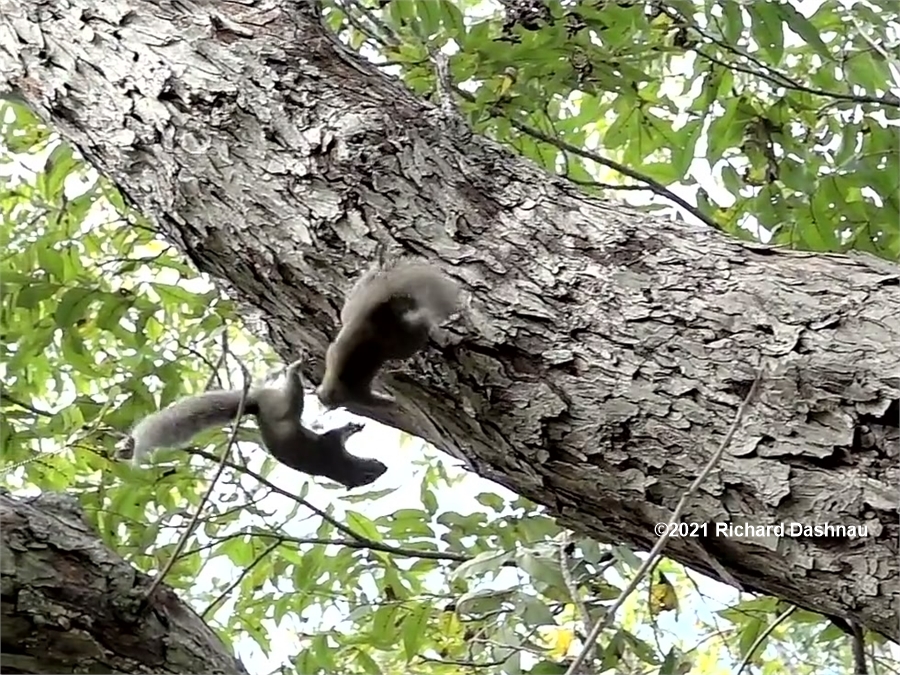
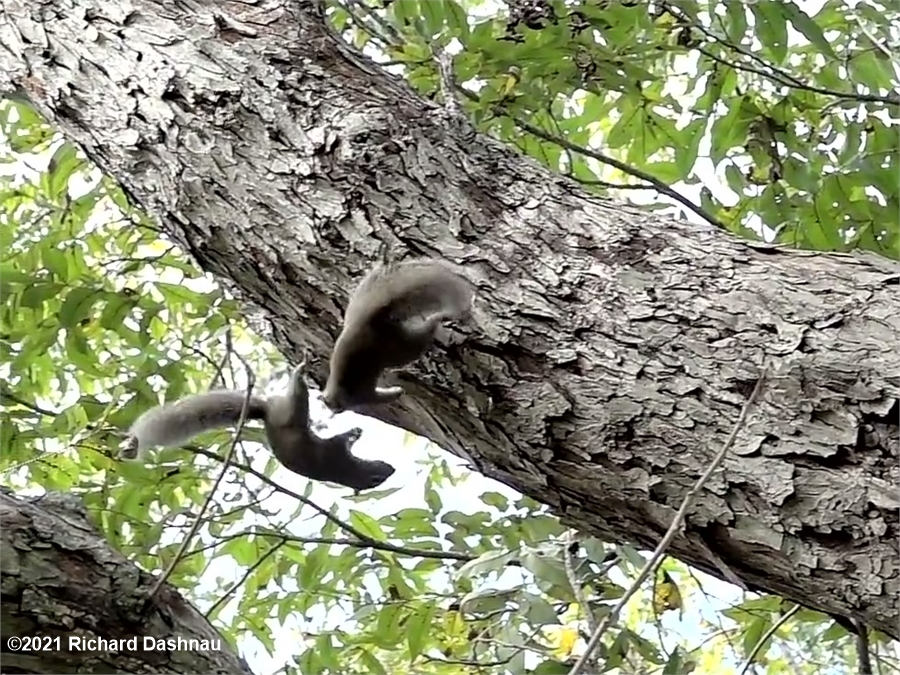
Arrow shows direction of DOWN.
Squirrel on the left was
holding to the bark.
Piece of the bark peeled off at
hind feet!
Missed first grab with front paws.
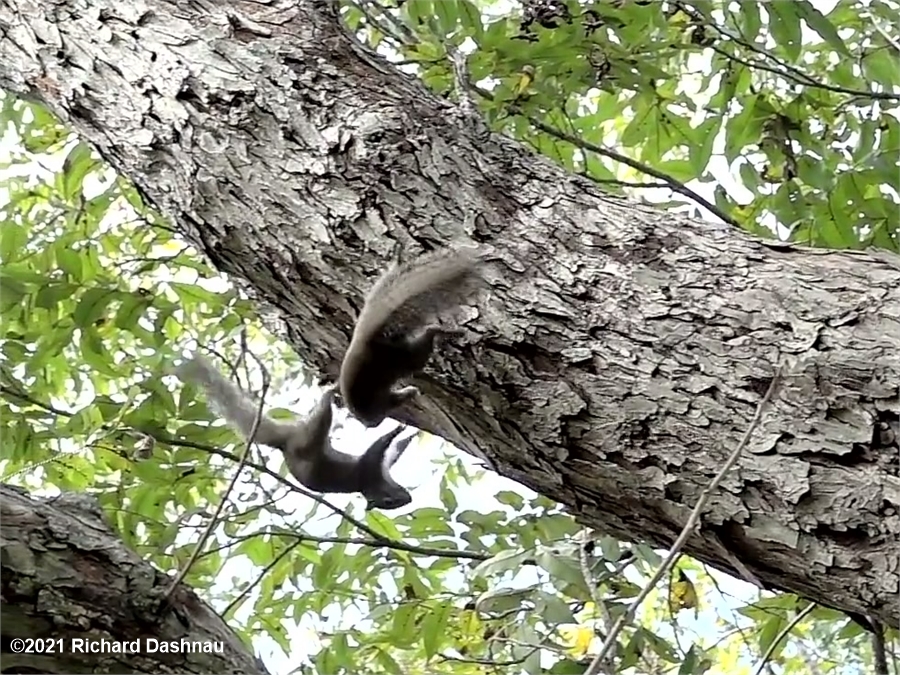
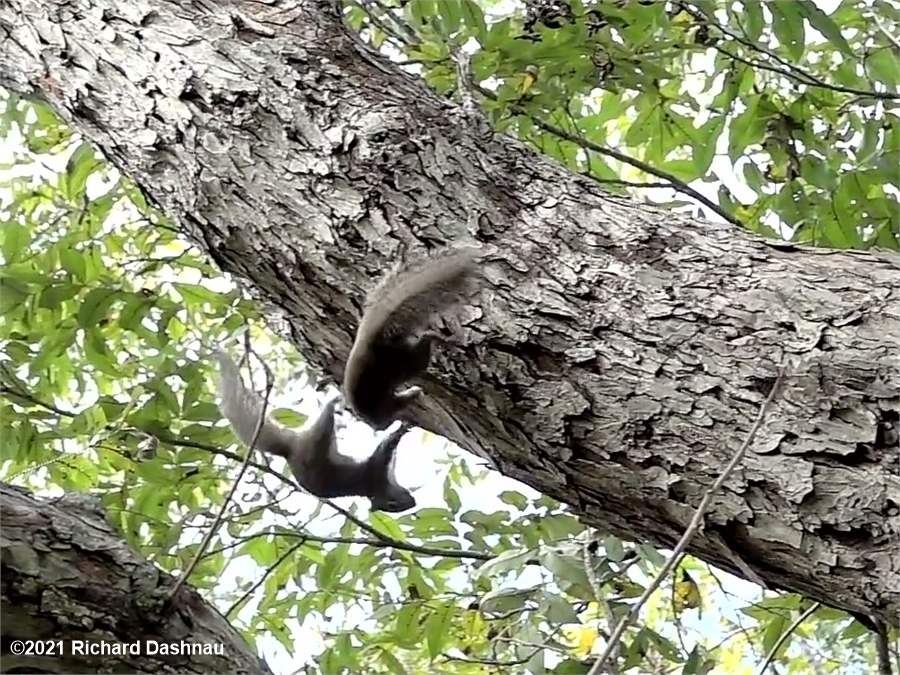
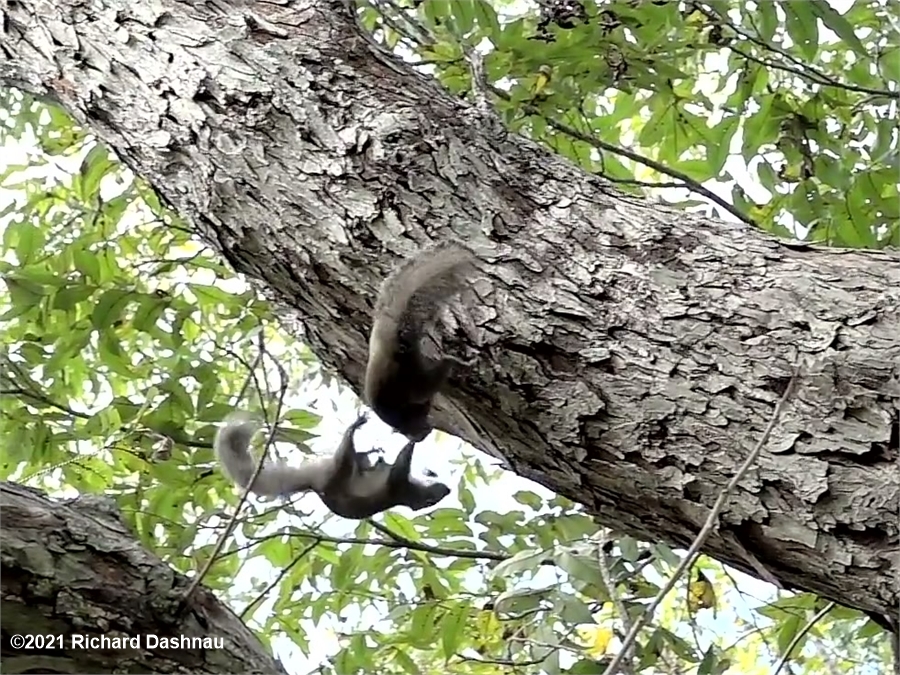
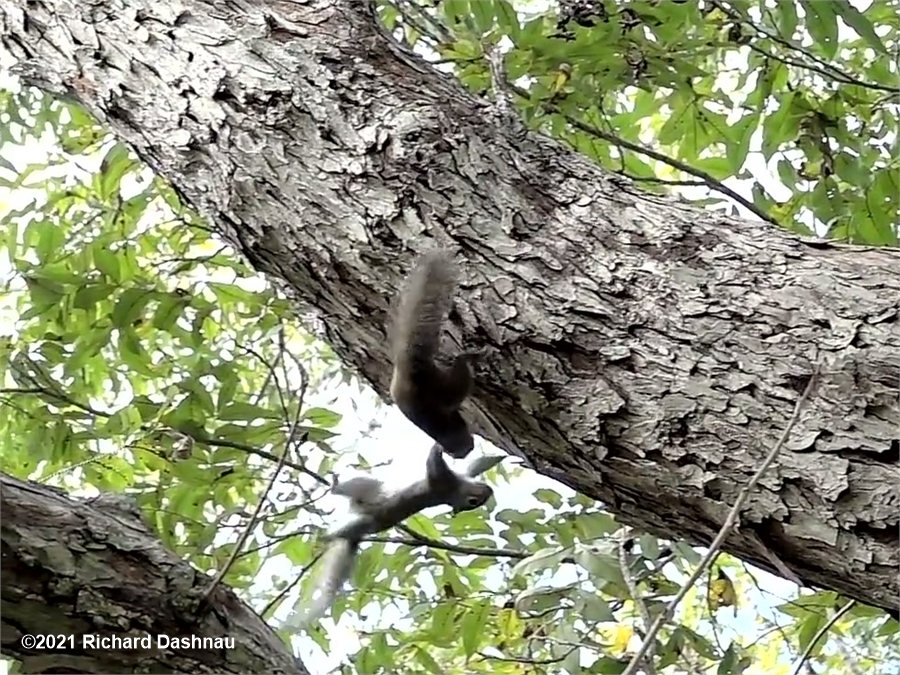
Both front paws still free .
Left
front claws snagged the bark!
Front left claws grab, and
quick pull.
Grab with the claws on the right paw.
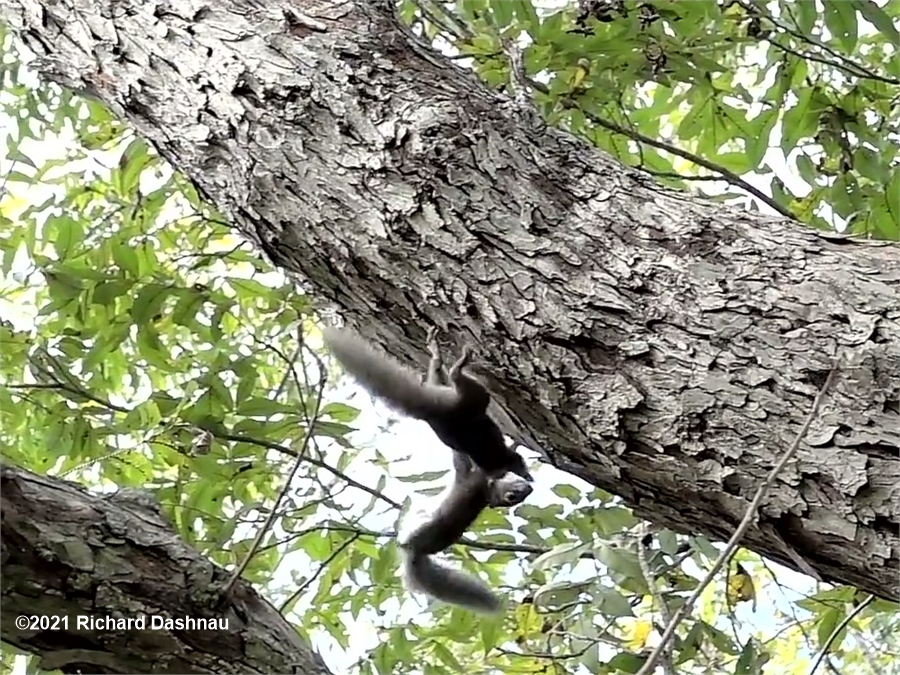
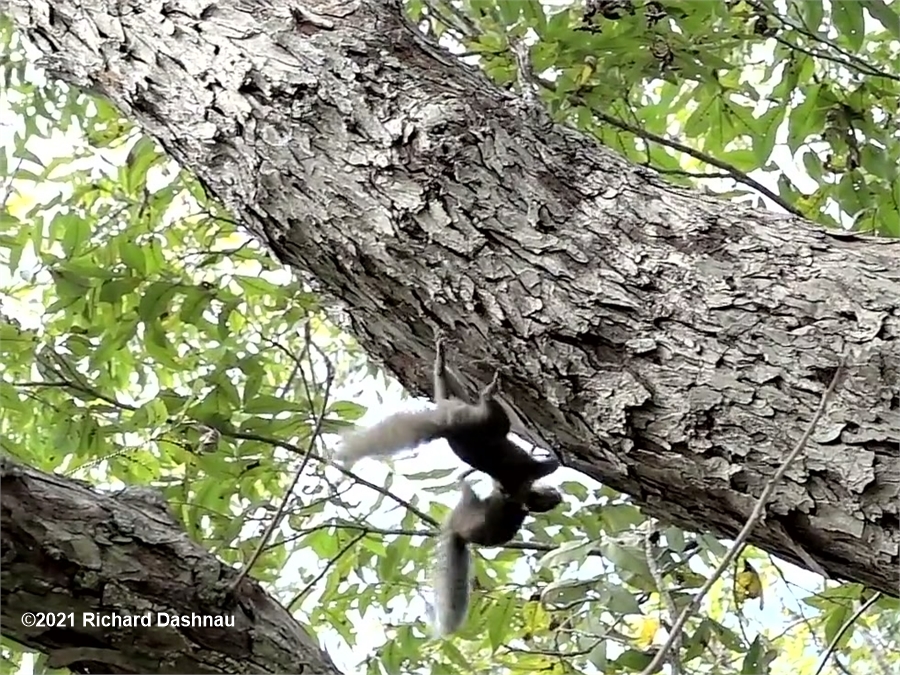
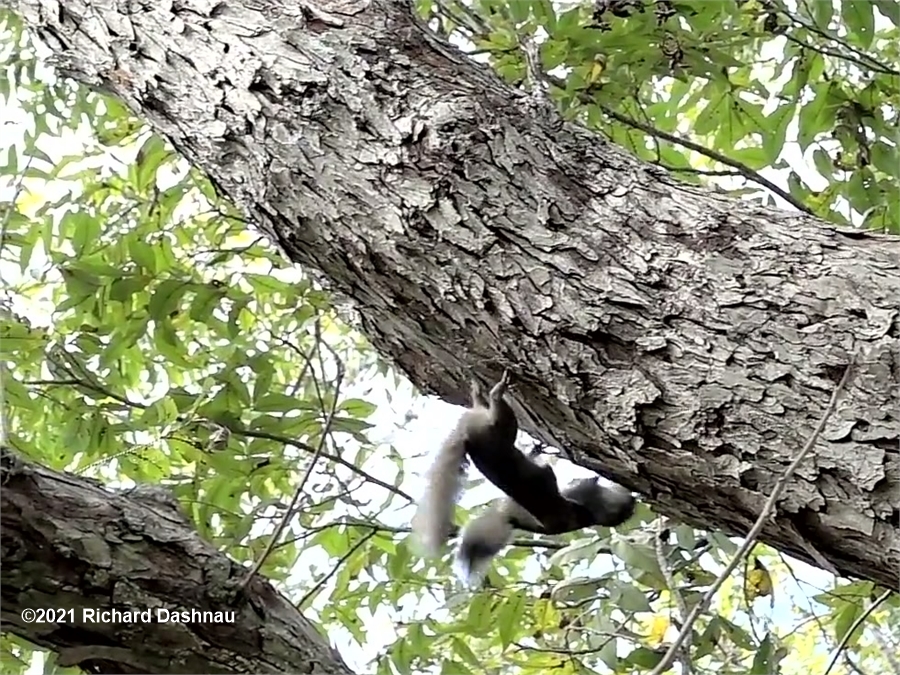
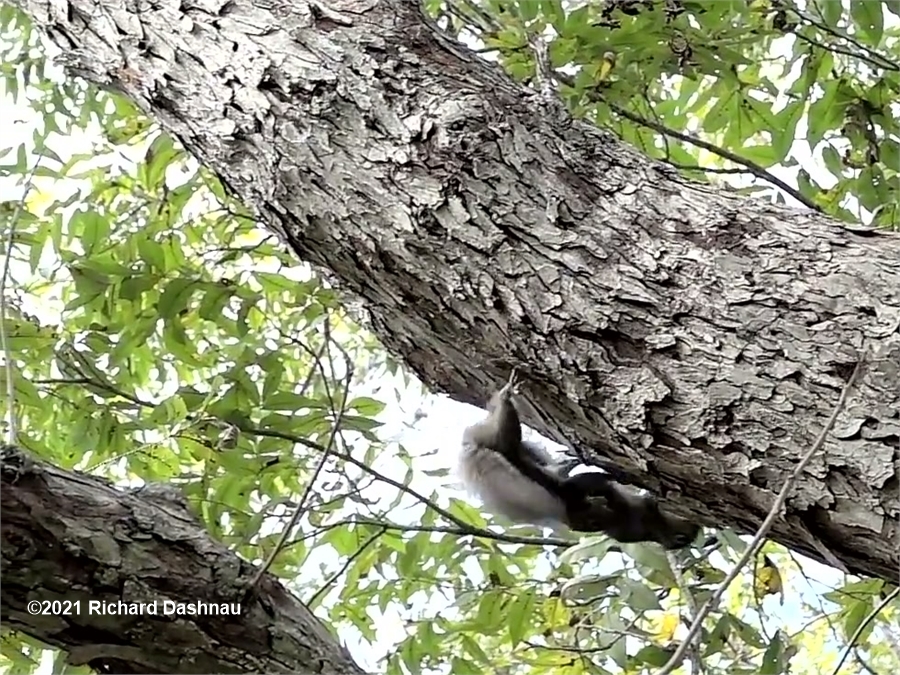
Rear legs were in free
fall!
Pulled back with front paws, brought rear feet
up!
Rear feet up to the bark.
Pushed off with back feet to move forward.
On
10/17/2021;
I was at BBSP near the tree where I'd seen the baby alligators
a week
before (10/11/2021). I've mentioned the busy squirrel that I
saw then.
On the 17th, I went by the Oak Tree again, because I'd hoped
to see the squirrel at work. I did see a
squirrel come out of the tree! So I shot video and hoped
for
the best. The images below are frame grabs from the
video clips is got, which I've edited into this very short film.
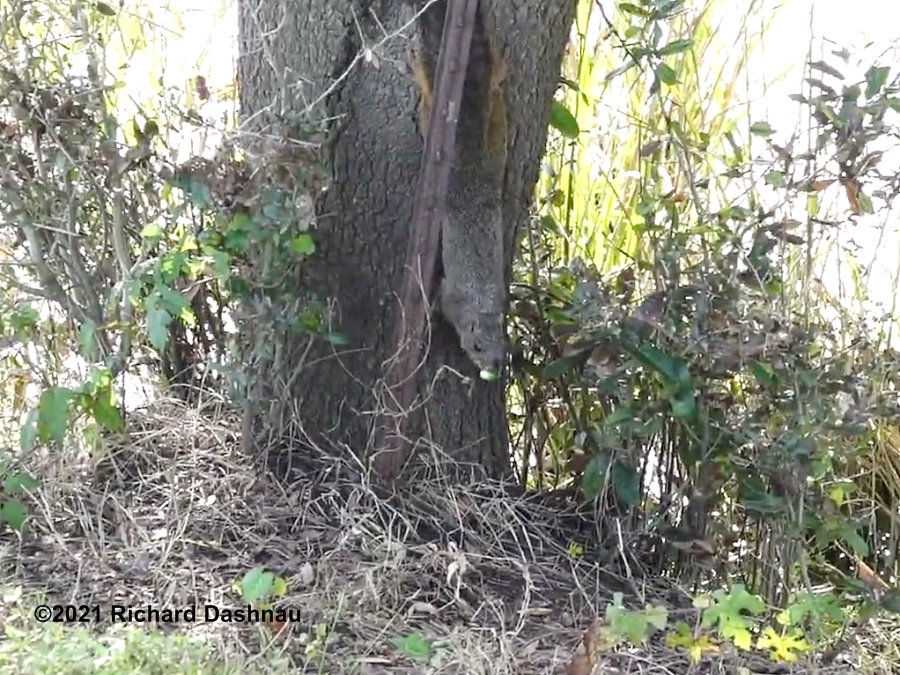
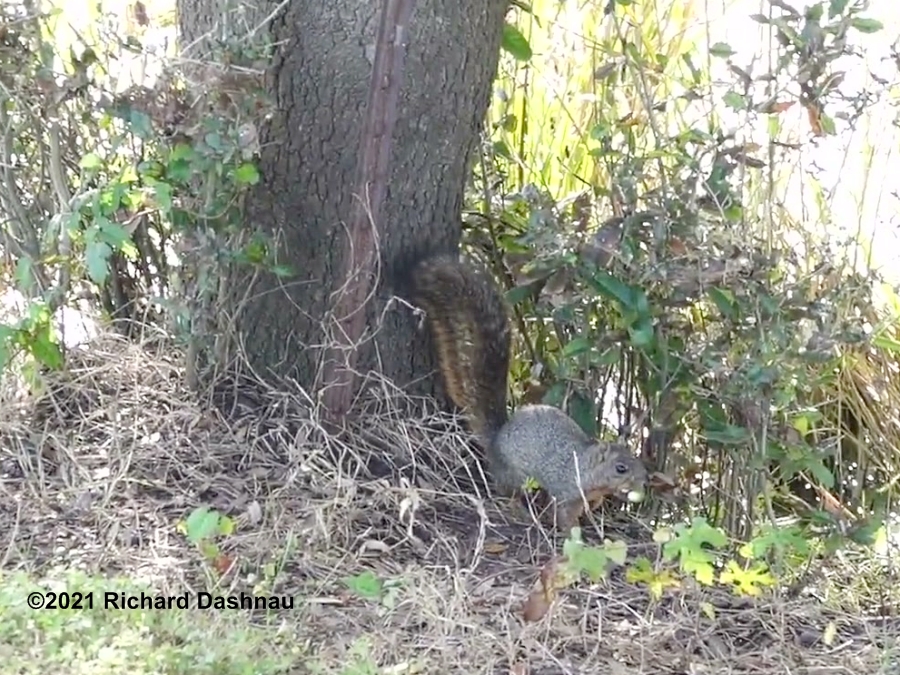
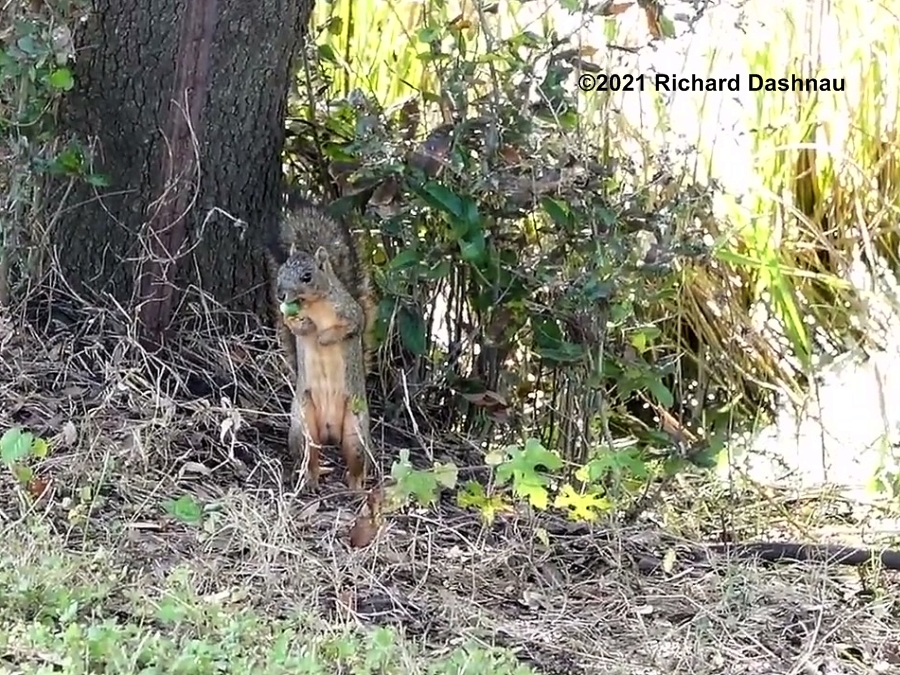
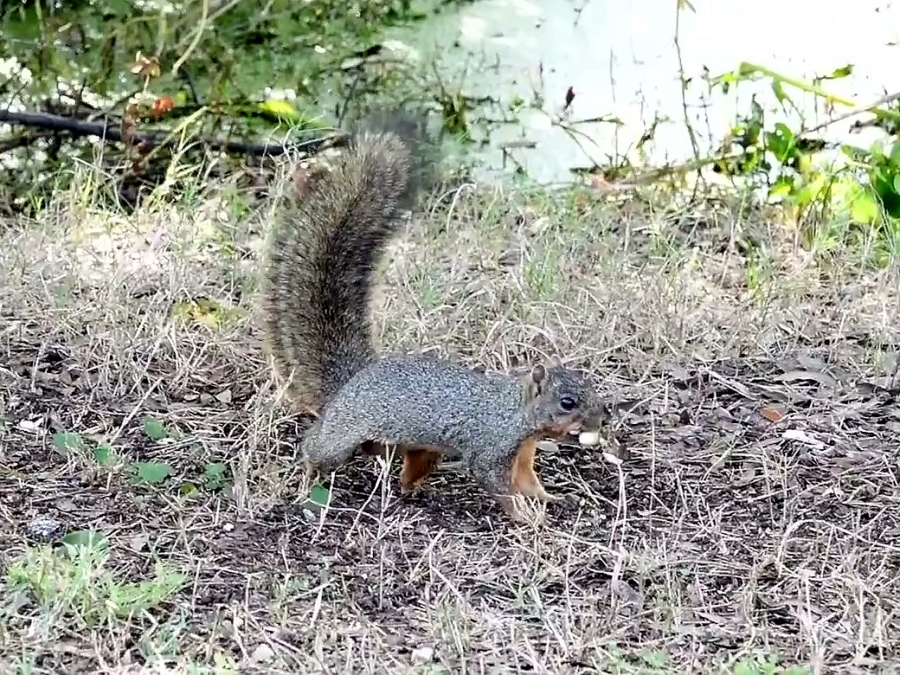
It
came down the tree, and watched me. It moved by me taking a few
steps, then pausing to watch. It was only about 3 yards away.
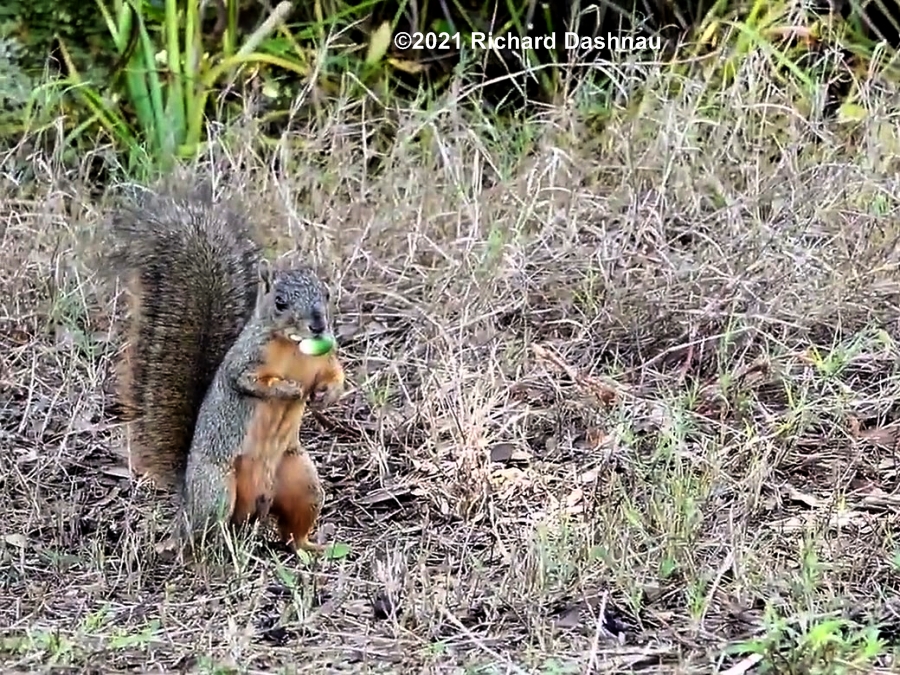
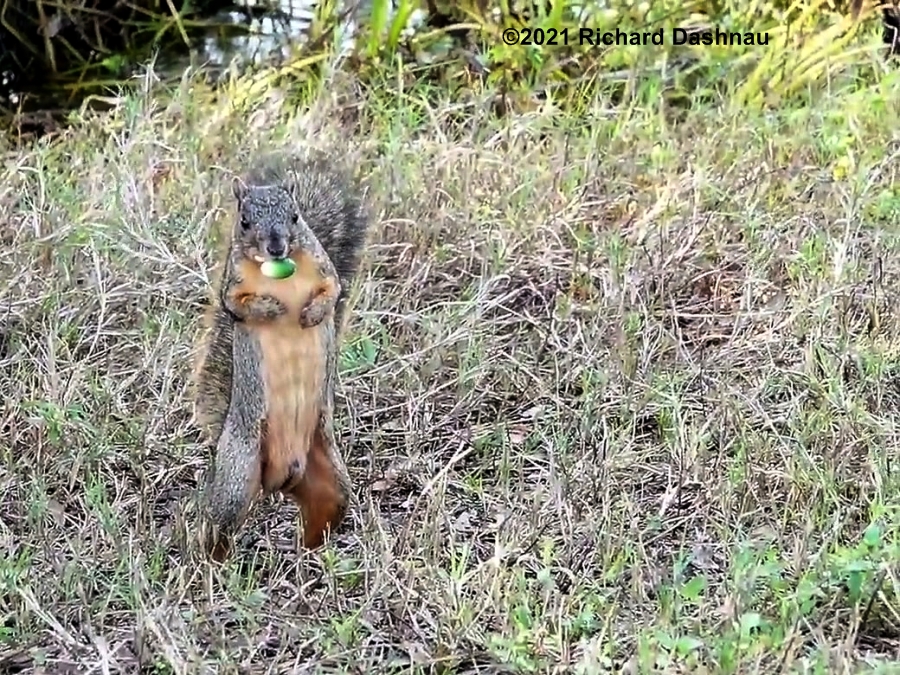
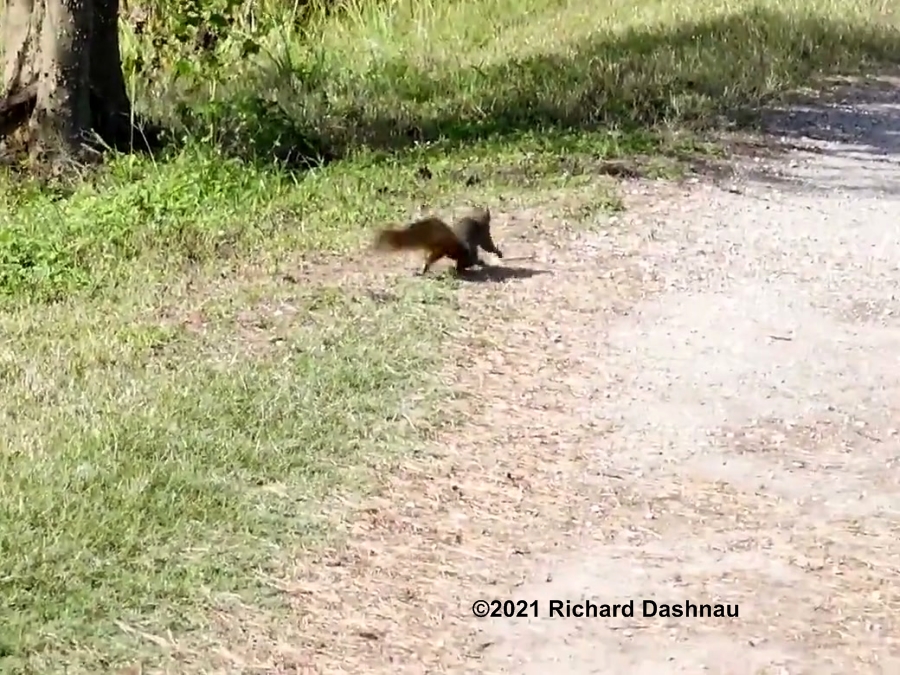
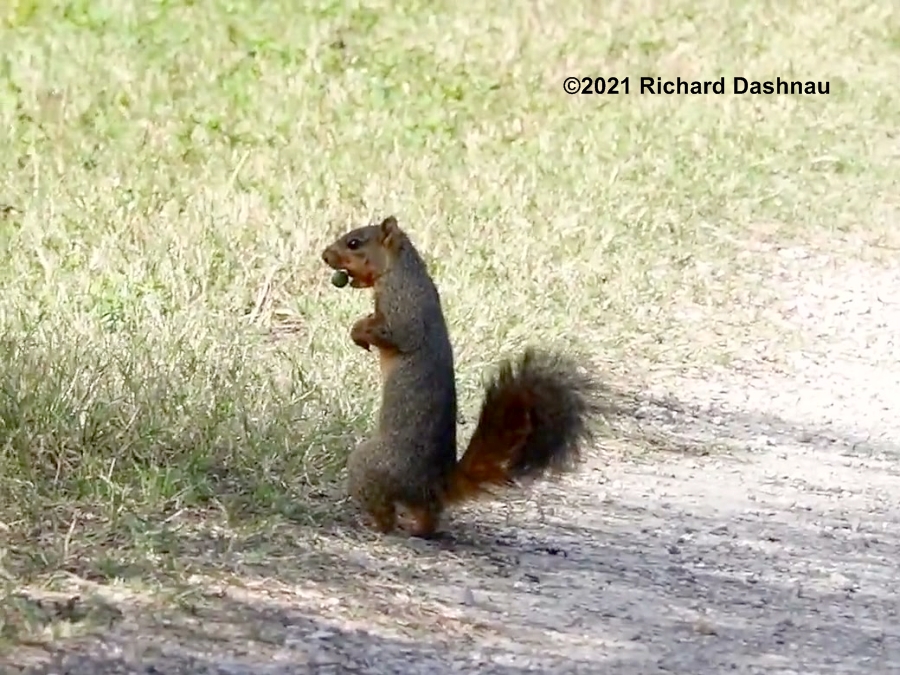
When
the
squirrel stood, it made tiny squirrel fists with its front
legs. It appeared to be challenging me to a
fistfight--but of
course it wasn't. The squirrel finally took off, and
ran past me.
It didn't stop at the tree that was being used a week
ago (that
tree shows in the third picture above). The squirrel
kept moving
(pausing occasionally).
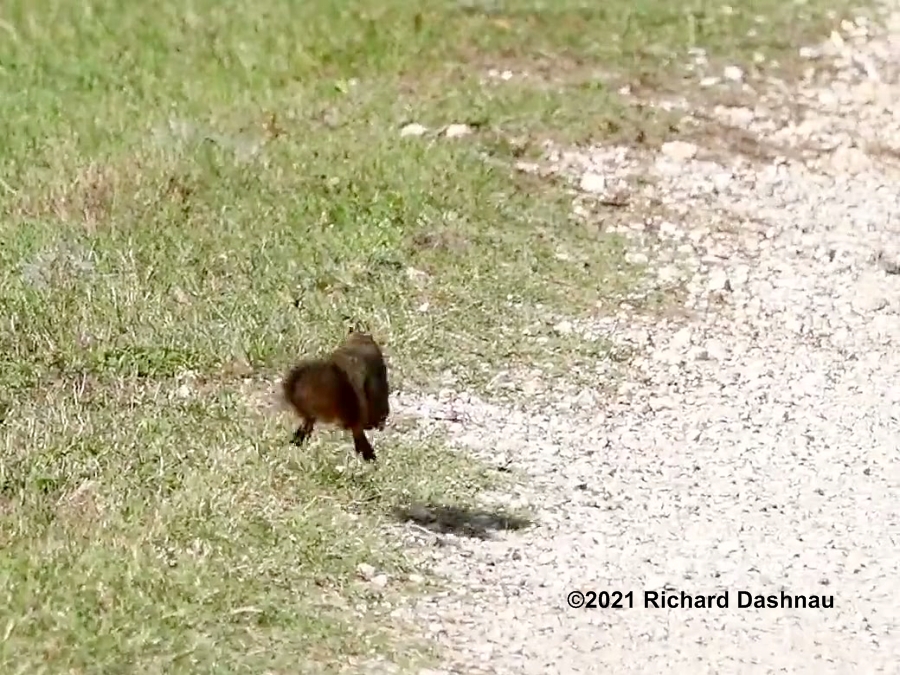
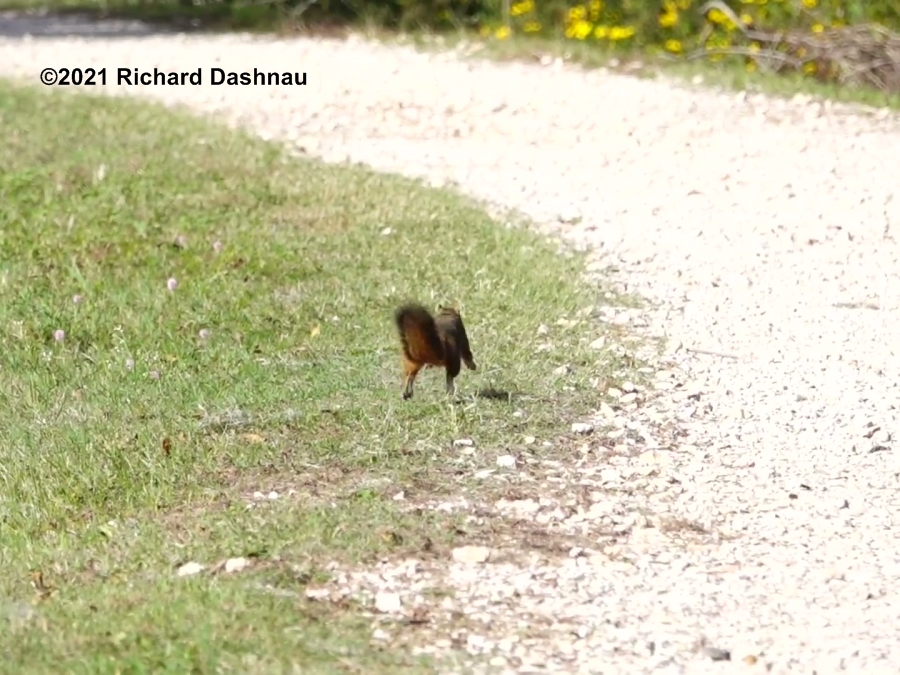
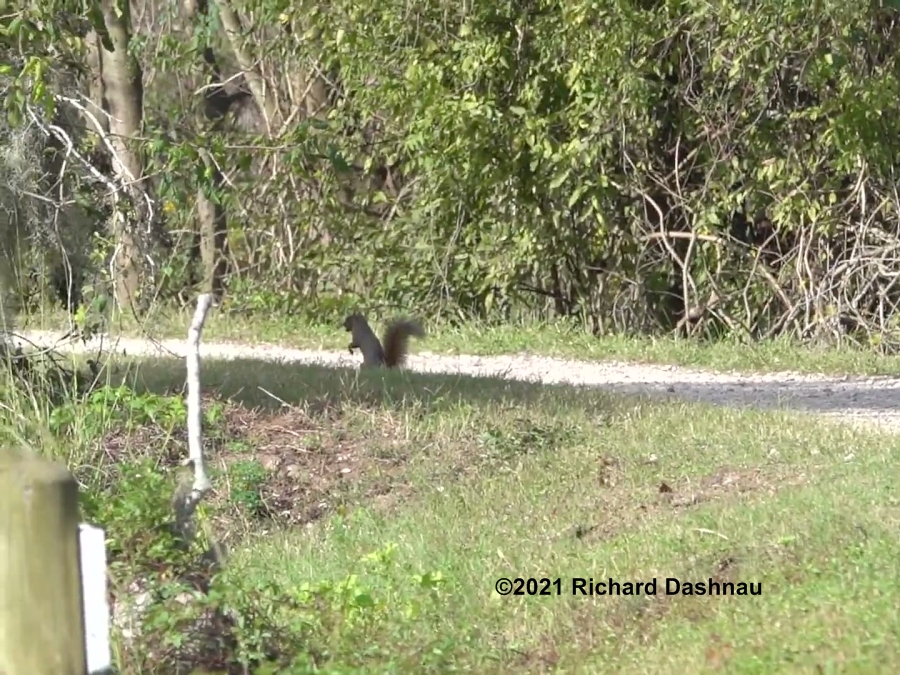
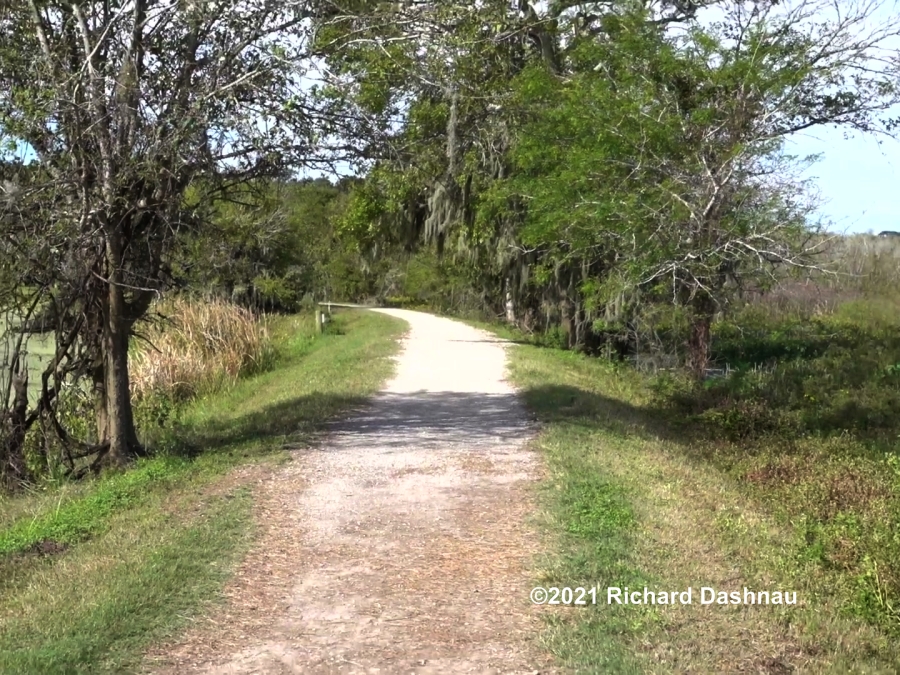
The
squirrel
kept moving (pausing occasionally) until it ran around a bend
in the trail. I think that bend is about 140 yards from
where I
was standing. I'd hoped to catch a return
trip by the squirrel. I
saw one appear at the bend down there, but a young park
visitor scared
it, so I didn't see the squirrel again.
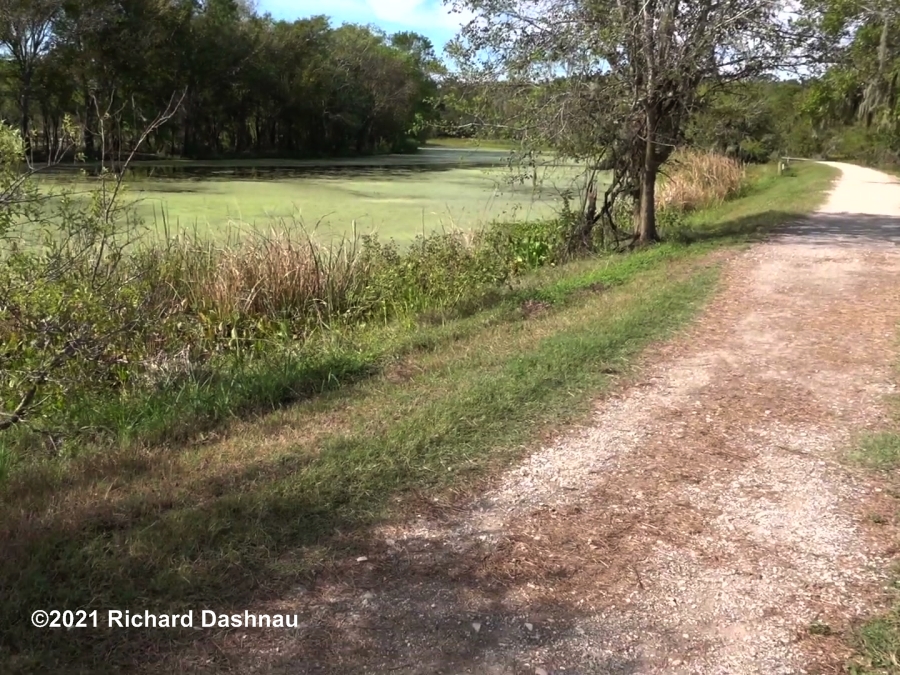
05/02/2021 Even
with more "spare time" it's taking me days to work on new material so I
can post it. Part of the reason is that I get more
new material before I've completed
editing of the previous new material--because I have more of that "spare
time" to go get the new material. Oh, darn. LOL
So, here's how my morning went at Brazos Bend State Park on 05/02/21.
I have more
photos (and some video) but I need to post this now before much more
time passes (it's
already
been a week today). I'd just gotten to the edge of 40-Acre Lake
(had just walked down the hill) when I noticed this set of animal
tracks on the trail. I'm a bit confused
on what made them. I
think they're from a cat because of the short heel pad and outline; but
it look like there are claw impressions and a single "lobe" in front
and two "lobes" in
back--which would make them dog tracks.
Whatever they are, it looks lke they walked on top of the human
tracks. I'll alter this description pending any expert input. If
they are
feline
tracks, then they'd probably be from a Bobcat, which would be pretty
cool. (UPDATE)--Alas.
According to a number of experts, my
second guess was correct. They were
dog tracks. Thanks
to science
twitter folks: Dr. Lisa Buckley (@Lisavipes) ; Dr. Anthony Martin
(@Ichnologist); Zachary Wardle (@ZacharyMWardle).
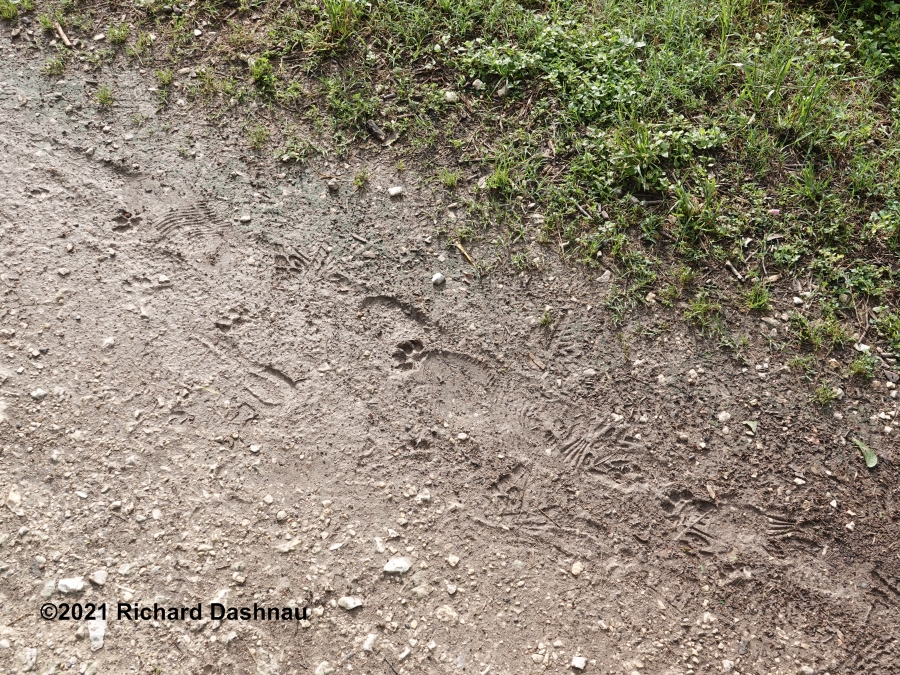
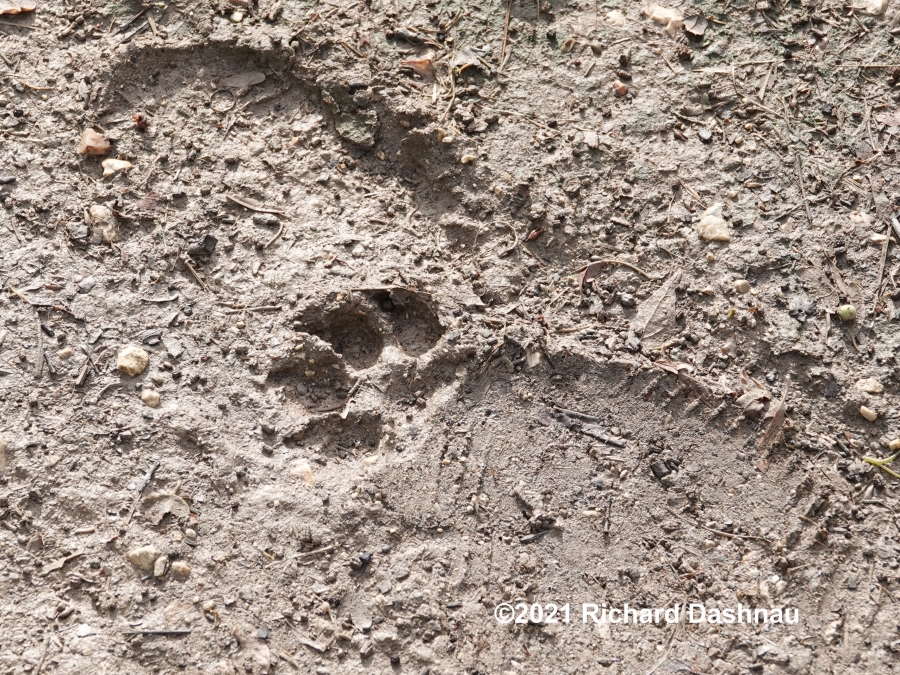
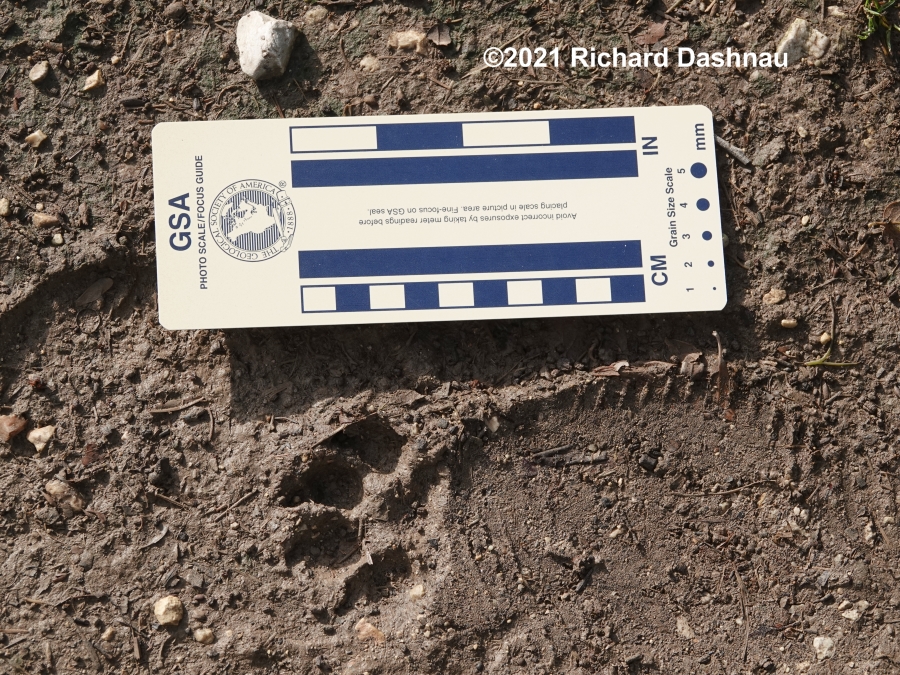
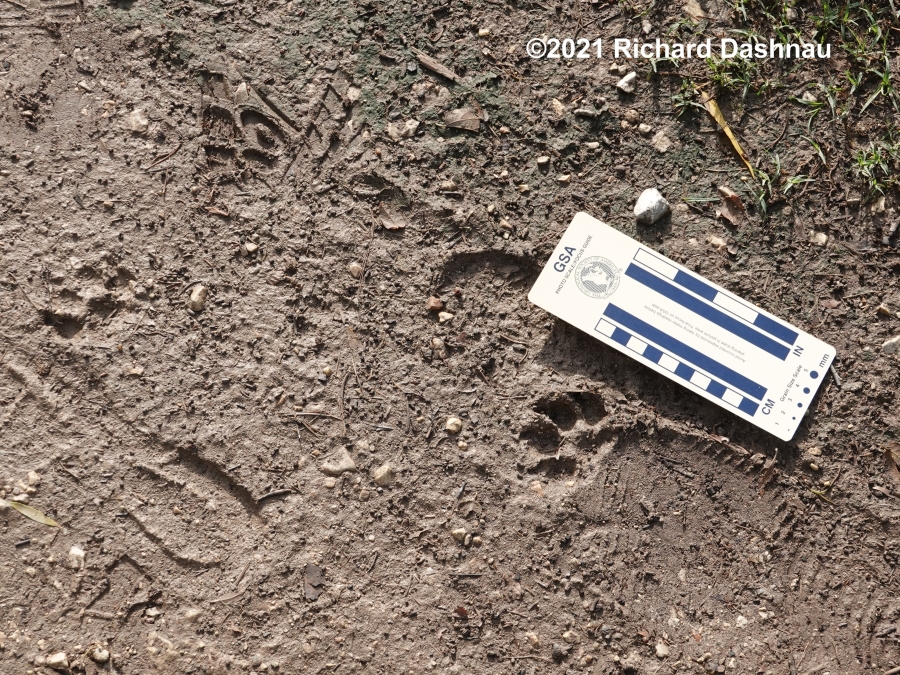
Animal tracks!
04/14/2021 While
walking Piper this morning, another Armadillo (Dasypus
novemcinctus)
ran across the road in front of us. It crossed 2 lanes, a median, and 2
more lanes before crossing the sidewalk
on our side of the street. Then
it took cover behind a hedge and moved toward us. It either heard
Piper's tags, or me telling her to behave (though I tried to be quiet)
or smelled us--but it tried to get through
the wall near us. It had to pass us, and then moved away. I
thought that was the end of it.
A car passing on the other side of the street made a U-turn and
came to
talk to me. We'd started talking about the armadillo when I noticed
that it was crossing the road again!
I uttered an expletive (sorry
to the driver for that) and looked further down the street. The
streetlight down there had just turned green, and it looked like at
least 5 cars were
heading our way--and they drive fast on this
street. I decided to run after the armadillo and chase it across
the other lane before the cars got there. So I did. I had my phone out
and
have shot video of the armadillo near the hedge, but I didn't film my
chase.
I had to keep track of oncoming traffic, my location, Piper on
her leash, and the armadillo--so adding
"manipulating phone to shoot
video" to my list of tasks was not a good idea. We all crossed
safely, and I crossed back and continued home. I hope the
armadillo remained safe.
The
images below are frames from the video clip, which
can be seen here.
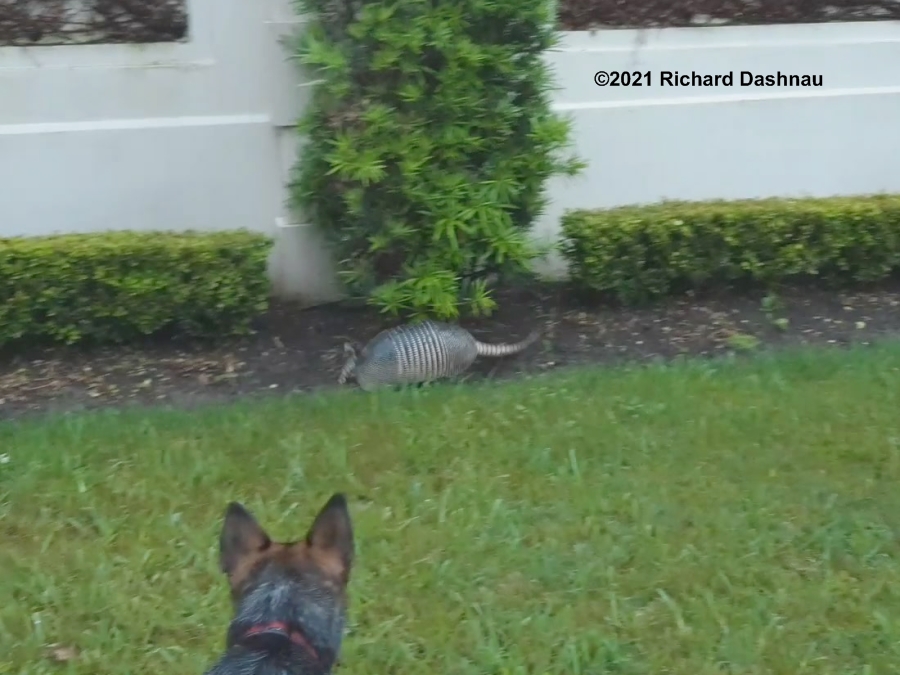
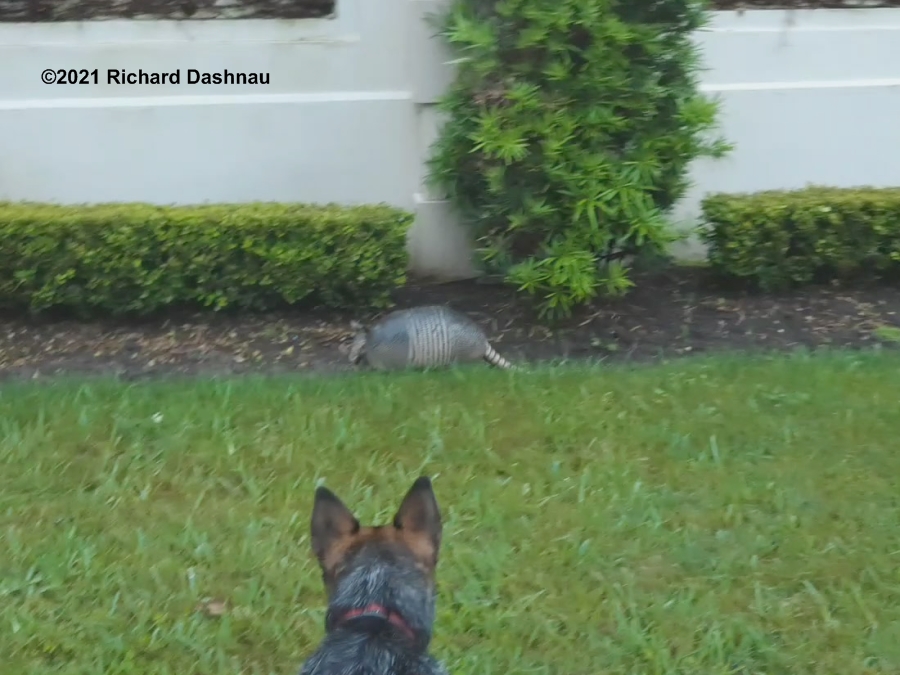
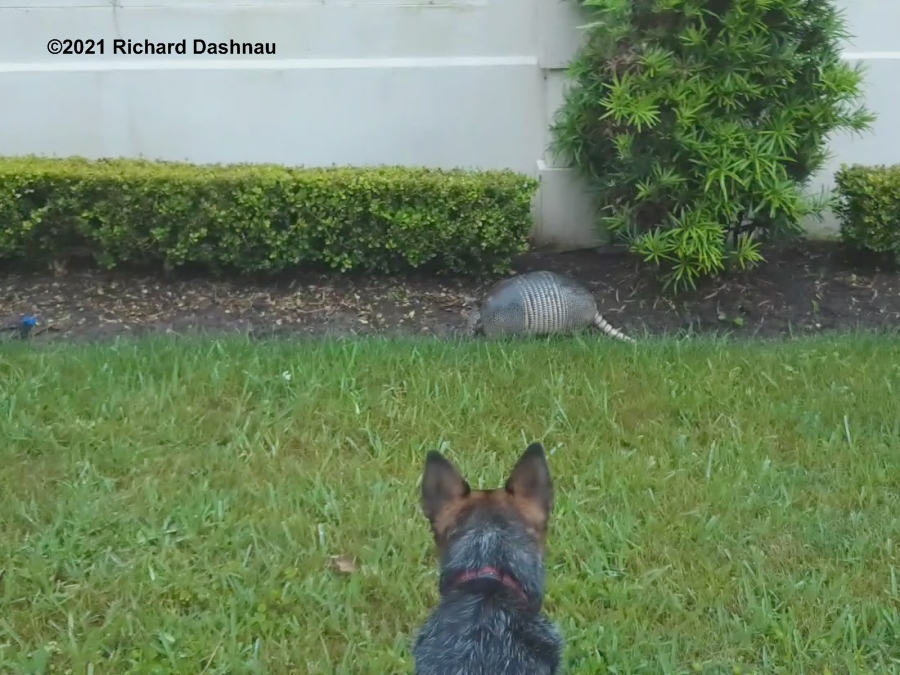
03/07/2021 I
started as a Volunteer ranger/interpretive guide at Brazos Bend State
Park in 2001. Starting then, I went to BBSP at least once a week--EVERY
week; although
there were some periods where I had to go "on hiatus"
due to occasional medical procedures. In a single day, I could
interpret for over 100 people...or 10. I feel fair average of
contacts
would be 50 per week. 50 folks per week x 51 (weeks
in a year) would be 2550 folks per year. 2550 x 19years
is.... a LOT of people (48,450 --but maybe take off about 6 months'
worth
because of the medical stuff (that's about 1200 less)).
That still adds up to a lot of folks that I've experienced the
park with. It was great fun, and the park is a great place. And
then
our viral visitor appeared. And I stopped going to BBSP in
March of 2020. There were many factors involved with this--all of
us know the adjustments that were made. I missed the park.
I can't
remember exactly, but I did go out to BBSP a few times during 2020.
I also went out a few times in 2021. I decided I should go once
more while there was still some controls in place
so I volunteered
on March 7. During the 6 hours I was there I spoke with 100
people while wearing a mask and maintaining distance. It was
great as usual! There is always a lot
to see at BBSP, but I
think it will be a while before I go out there again. If you live
in Texas, you can probably figure out why after March 10. What
did I see today? Well, here we go.
There
was a mother Coypu(aka Nutria-Myocastor coypus) with at least 2
babies
on a little mat that they made from Giant Cutgrass. They were at least
50 yards away, so I couldn't
see too much. I passed them again on
my way back to my car, and pointed them out to a number of visitors
then. One of the babies went off to forage by itself, and I
noticed
the Ibis
behind it, so I tried to get some pictures with them both
included. They were quite far apart, so it was hard to get them both in
focus. That is not a White Ibis, but either a Glossy
Ibis(Plegadis
falcinellus), or a White-faced Ibis(Plegadis chihi). I've seen
people who can identify birds a lot better than I can arguining over
identification of one of these. I know
it's one or the
other. I can't really pick out the eye color, but the legs are more
gray than pink or red. From what I can find, grey legs would make
it be Glossy Ibis. The last 3 images
are frames from a video clip.
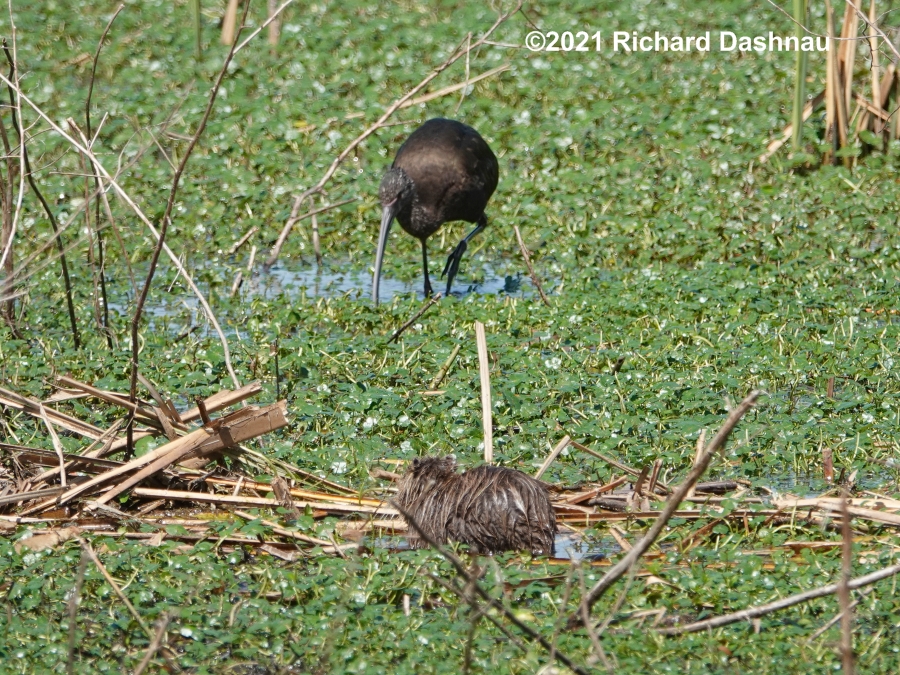
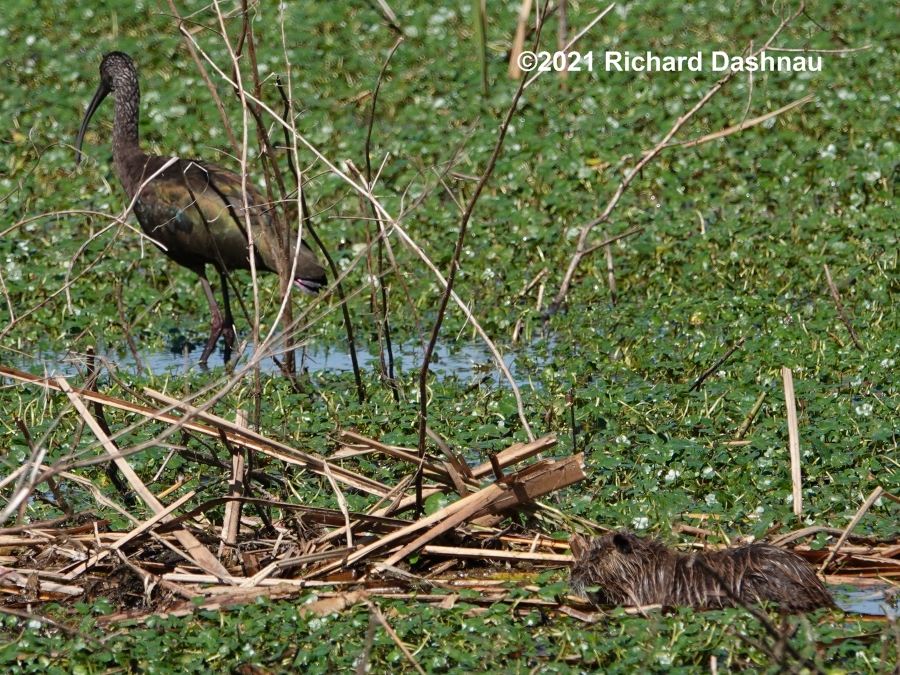
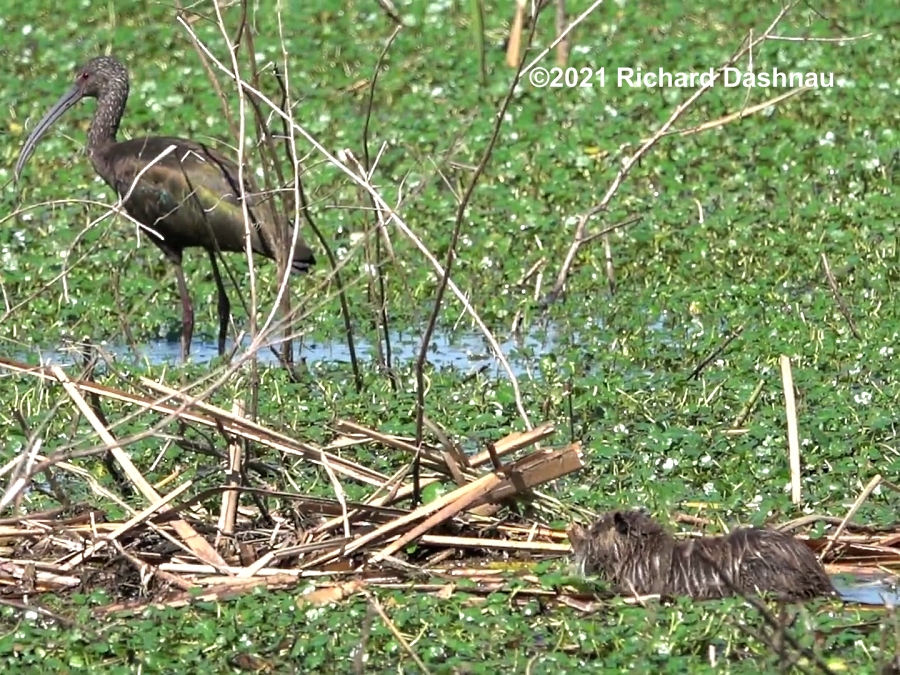
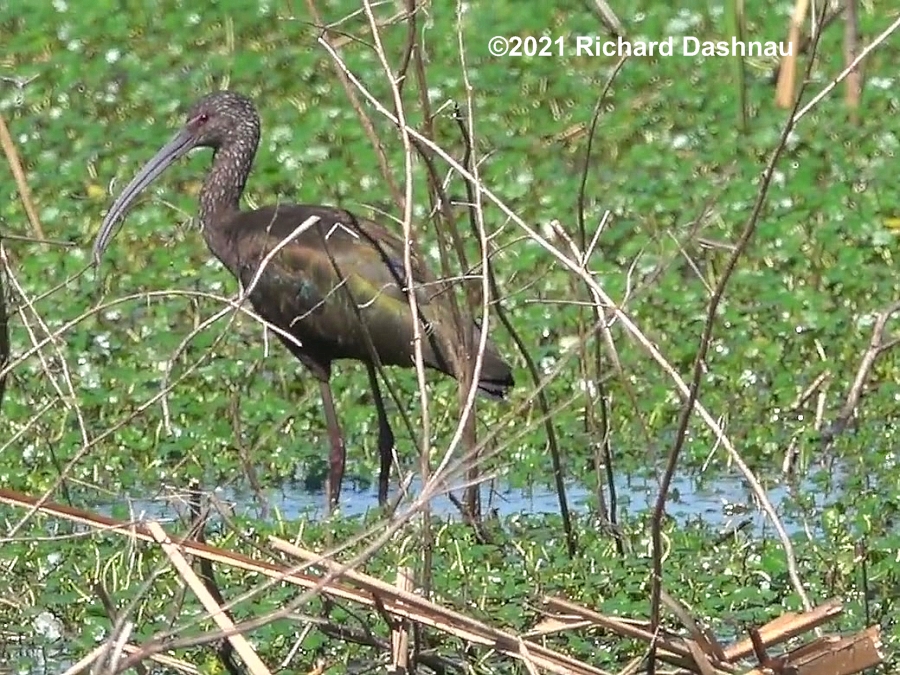
Ibis
is at least 20 feet away from coypu.
Three
moments as the Ibis paused.
Each view is a
bit different.
Just the
Ibis
Grey legs, not red or pink.
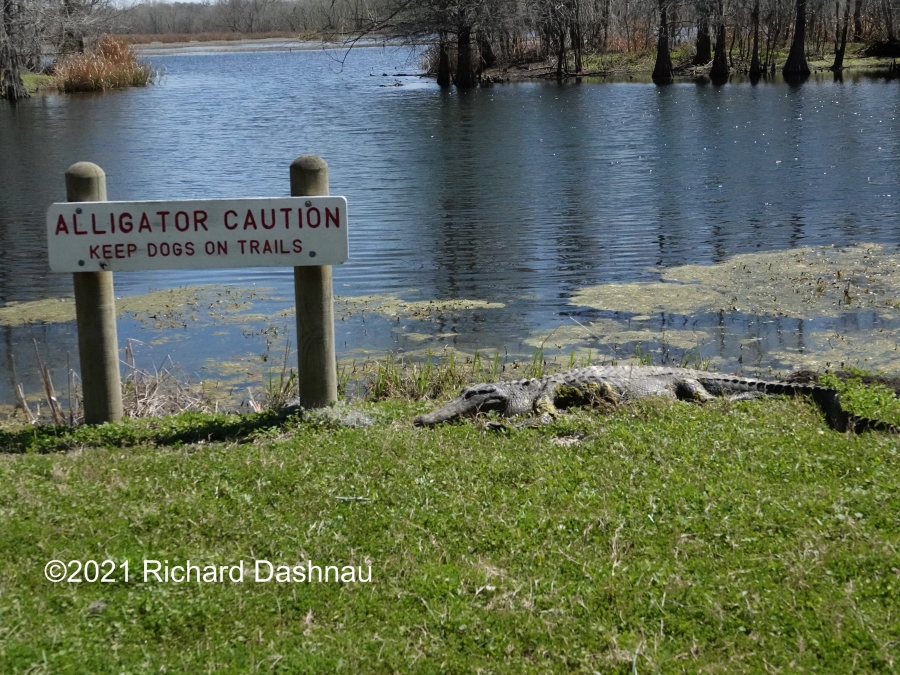
Just pay attention
to the sign, okay?
08/08/2020
Like
almost everyone these days, I've been staying inside. I
have stopped driving too far...
for purely recreational purposes.
I've also been avoiding parks that take much time drive to;
since we are generally asked to limit travel.
So,
today I finally went out to Archbiship Fiorenza Park (phase 2)
and I was happy
to see it wasn't crowded. I walked, but not far, since I wanted
to keep
an eye on my car. As in
many parks inside Houston, car burglaries
are possible (it's happened to me, and to people I know). I
shot some photos and some video, and then left--but I
decided I'd revisit soon.
I've always seen something interesting there.
On this trip, I tried shooting video of a Roseate Spoonbill
(Platalea
ajaja). The trick is, I was 140 yard away (according to Google).
If you'd like to see where I was--
I was at 29.720611, -95.626925 and I was shooting
one of the islands at 29.721946, -95.627022 While filming
the Spoonbill, I noticed something swimming across and
filmed that.
I'm
pretty sure it was a Coypu (Nutria). As I may have
mentioned on
one
of my other pages, "nutria" in Spanish means "otter".
To
avoid some confusion, I try to use both terms
during
conversation--especially pointing out that Coypu are not related
to
Otters at all. Coypu (Myocastor coypus) are in the order
Rodentia,
along with beavers, squirrels, rats, etc.
while Otters are in the
order Carnivora (both animals are further separated in those
orders into groups containing their closer relatives).
"Myocaster" (myo - caster) is
Greek for "beaver-rat".
The image below is from what I edited into
this video clip (mp4). The video is not that good, but I'm
posting it because of recent reports of Coypus being seen-and
being a nuisance-at
a
park in another part of Texas (Fort Worth). There, people
have
been the Coypus and they are getting everywhere. The park
described in the articles (linked below the picture)
seem relatively
small and without much cover. These factors can bring the
Coypus
into contact with humans. Feeding these wild animals isn't
helping...but the pictures show them eating
food that was
probably intended for the ducks (feeding the ducks isn't a great
idea
either). Also, it's unlikely that there are any predators
around
(mostly thinking of alligators) to
help eat some of the
Coypus. Brazos Bend State Park has 5000 acres, 7 lakes,
lots of
cover, and a number or predators (at least alligators, bobcats,
coyotes) that can eat Coypu.
I've seen alligators eat them many times. Here's one page that has images showing this.
Fiorenza park has a lot of water, islands, cover, and at
least one alligator (I've seen it)
and
I've talked to people who've seen coyotes there. I know Bald
Eagles
hunt there, too. (I've seen them there--but not hunting.) Today,
I see
that there are Coypu there, but due
to these factors, Coypus are probably not seen very often.
To give some idea of the size of the park, I have some panorama
shots on this page.

Here
are some links to the articles (which will probably go away over
time):
Article 1 Article 2 Article 3
05/15/2020
While
walking
with Piper this morning, I noticed an armadillo walking towards
me about 50 yards away. I got out my cellphone and started
shooting
video. I was surprised to
find that there were actually TWO
armadillos. Piper and I watched as they moved towards us.
Then, one of
them turned and moved towards Piper! I'm sure this was
coincidental,
since I
believe that the armadillos didn't know we were there. I
tried to keep the leash tight as the armadillo moved a bit
closer. I
don't know if Piper or the armadillo moved first, but in any
case
it turned an ran. After a brief pause, the other one
followed. The
video is here (mp4). Armadillos (Dasypus
novemcinctus) are described as generally "crepuscular and
nocturnal" while feeding
(
The Armadillo:Its Relation to Agriculture and Game, 1944, E.R.
Kalmbach; page 15), though they can be oberved through the day.
In
fact, I've got examples of that on my pages here.
Today's observation was at 6:40 AM, with high humidity and heavy
cloud cover.
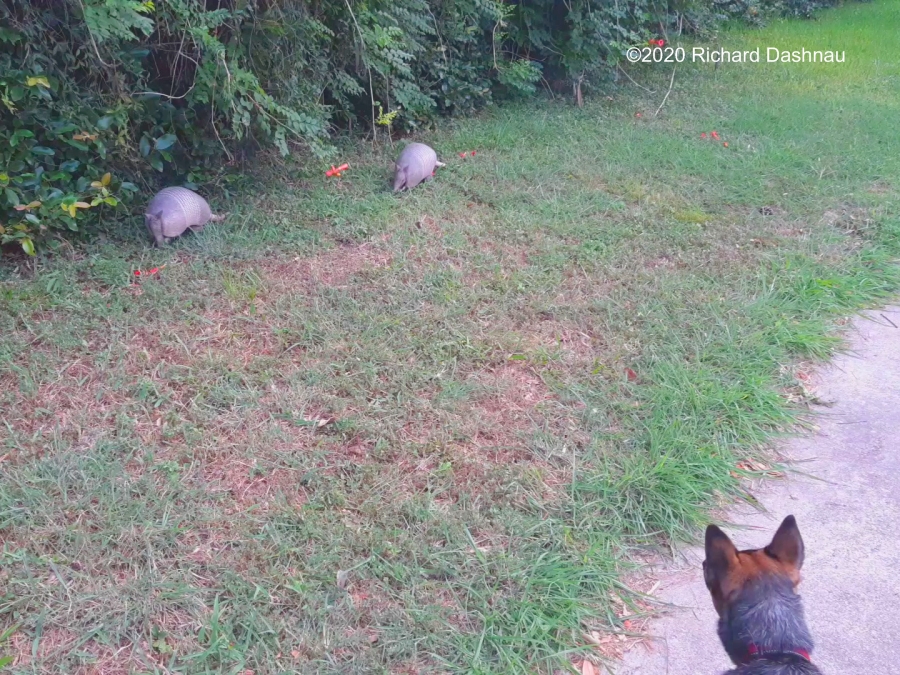
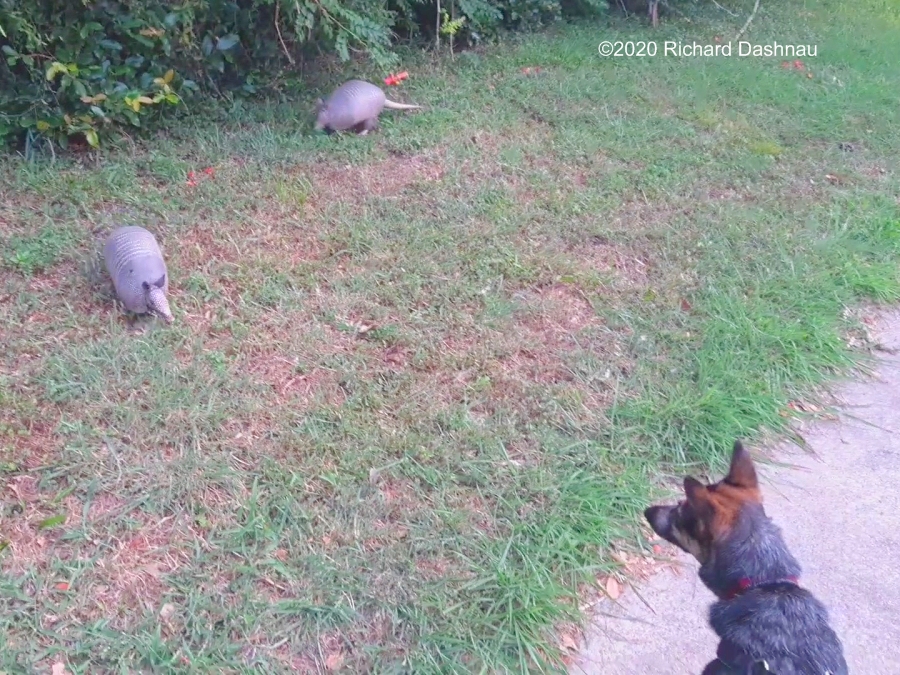
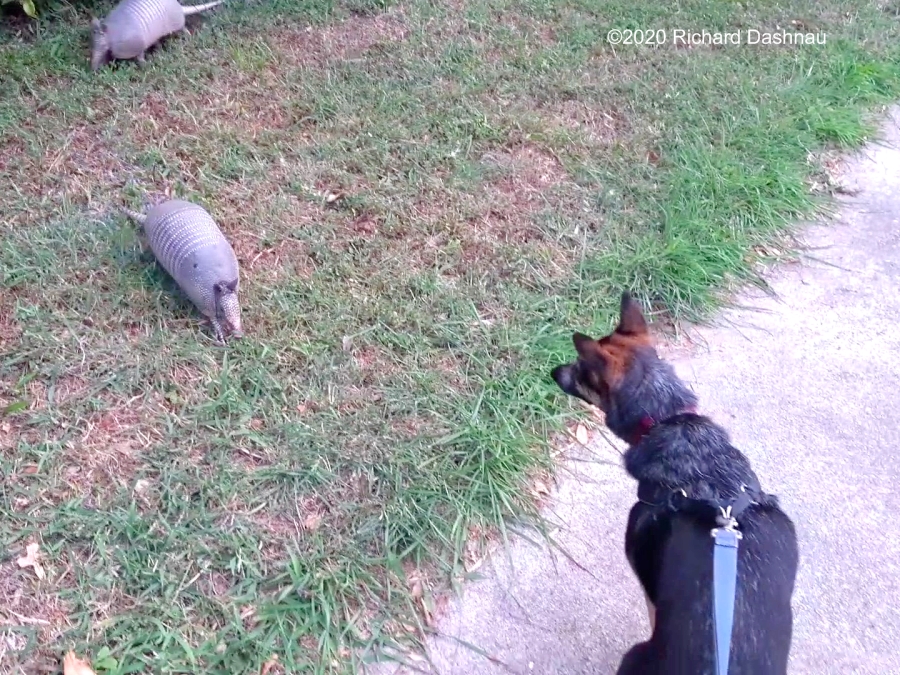
02/23/2020
On this cool morning(60 F) I found 2 sets of baby
nutria. The first
ones were sleeping with their mother at about 8:30am. Here
they are,
cuddled together
on a mat that they made from plant material.
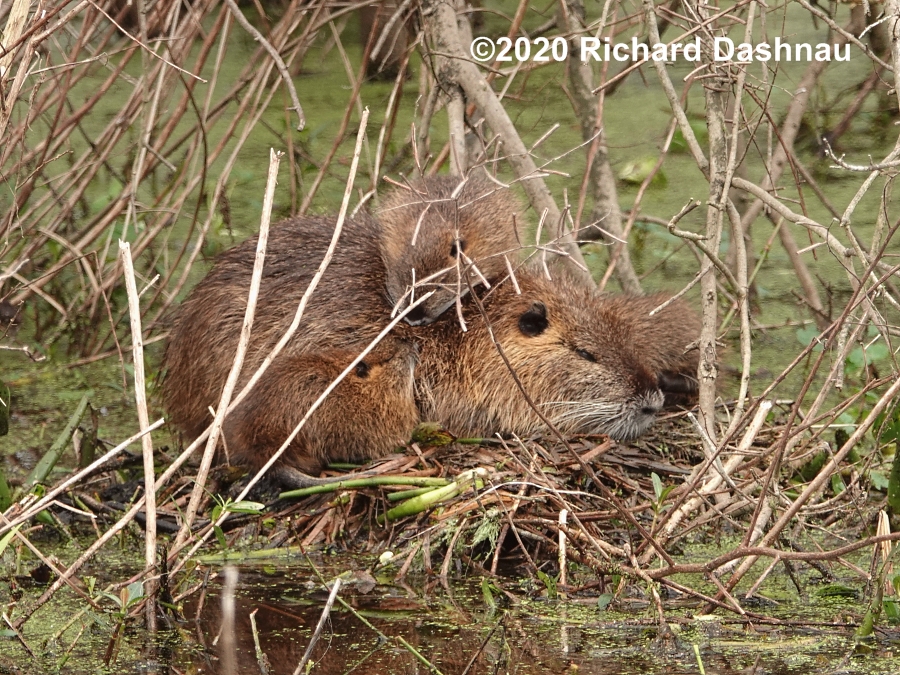
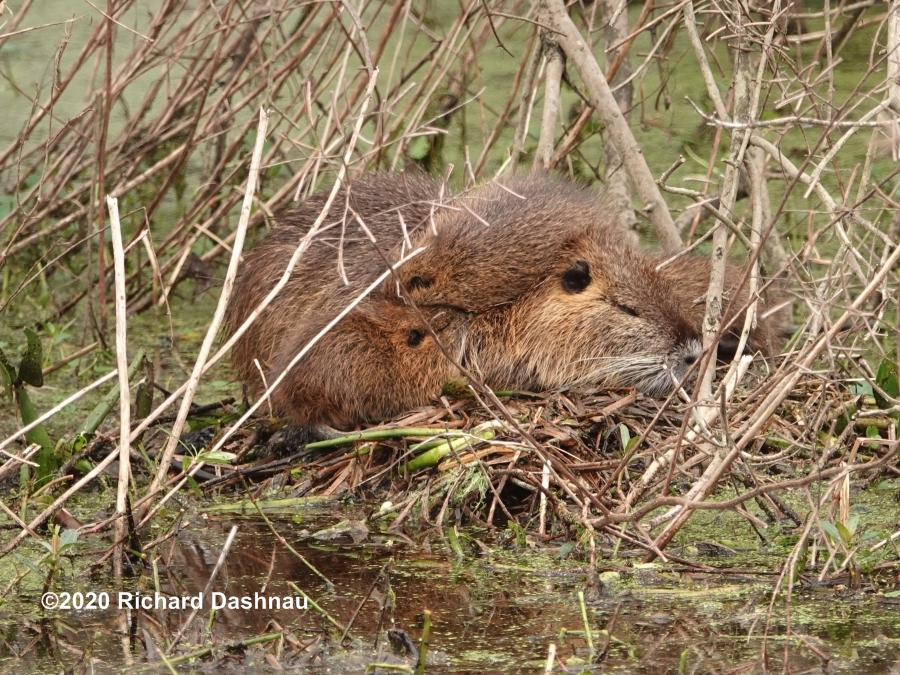
01
02
I
found another set of babies about 500 yards East of the first
set. This
time, just two babies were sleeping on a plant mat, at about
9:15am.
They were gone when
I came back at about 11:30am, but I got some
good pictures of their bed. Compare picture 3 and picture 6 for
before
and after leaving their mat.
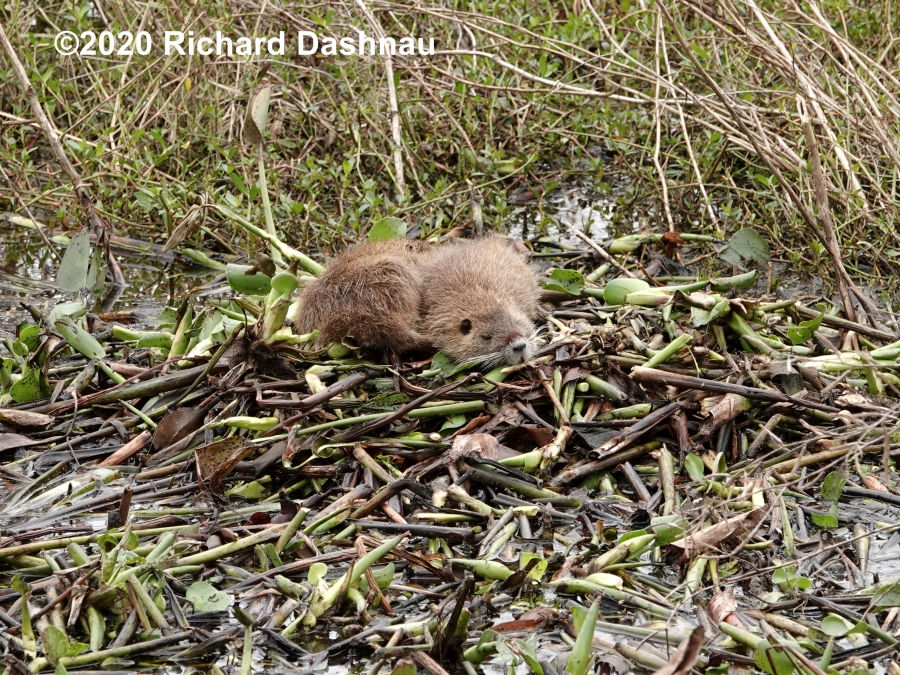
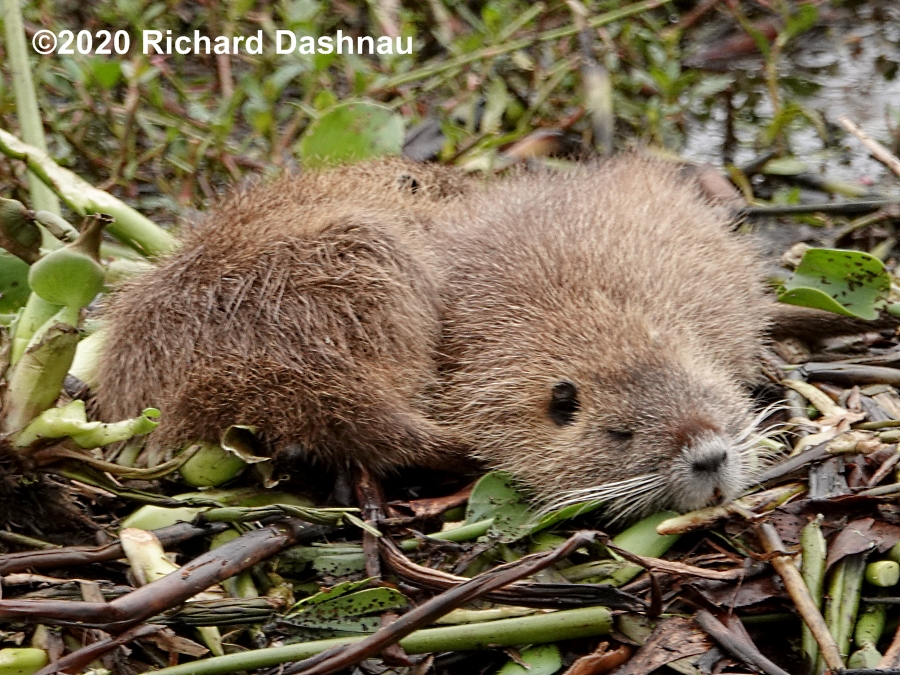
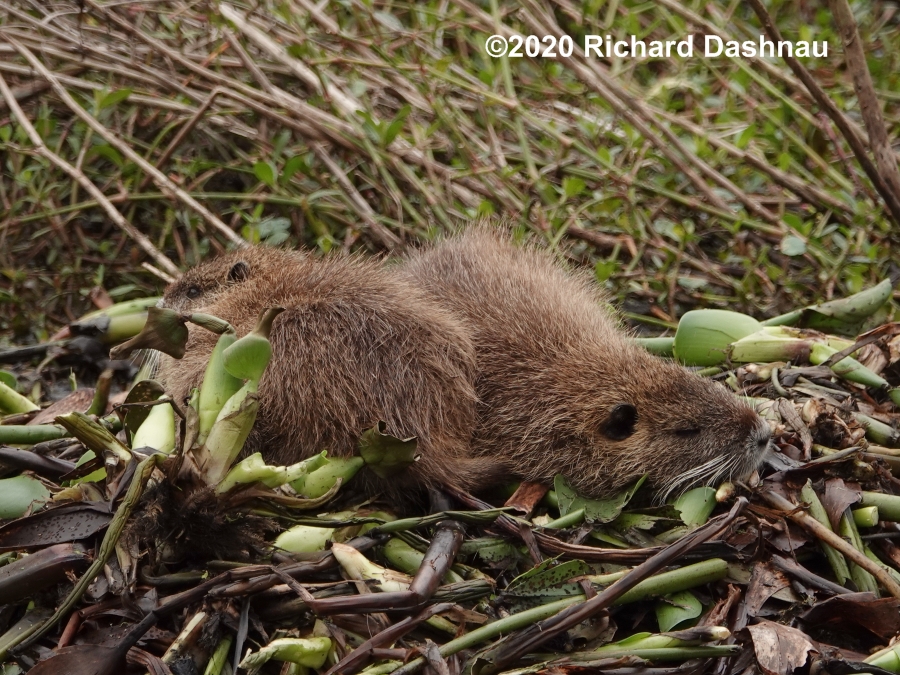
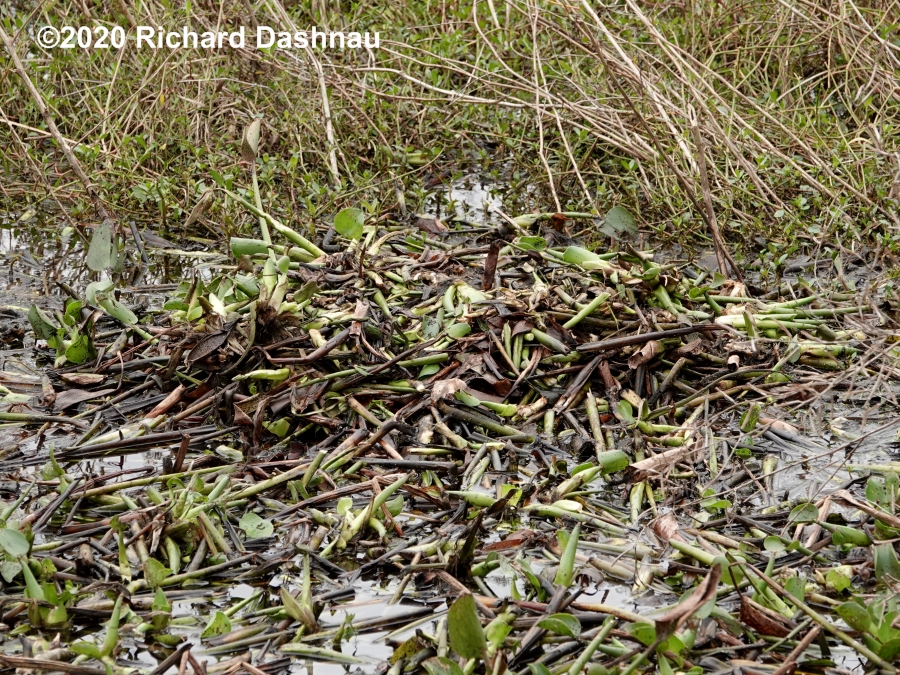
03
04
05
06
The
other
babies were still with their mom when I got back to them at
about
12pm. I shot some video as they shifted around. In the second
clip, the
babies are nuzzling the fur along their mother's
side, and one of the nipples can be seen for a second or two.
I've edited the short clips into this video file. Images 8, 9, and 10
are frame grabs from the video, with 10 showing the teat.
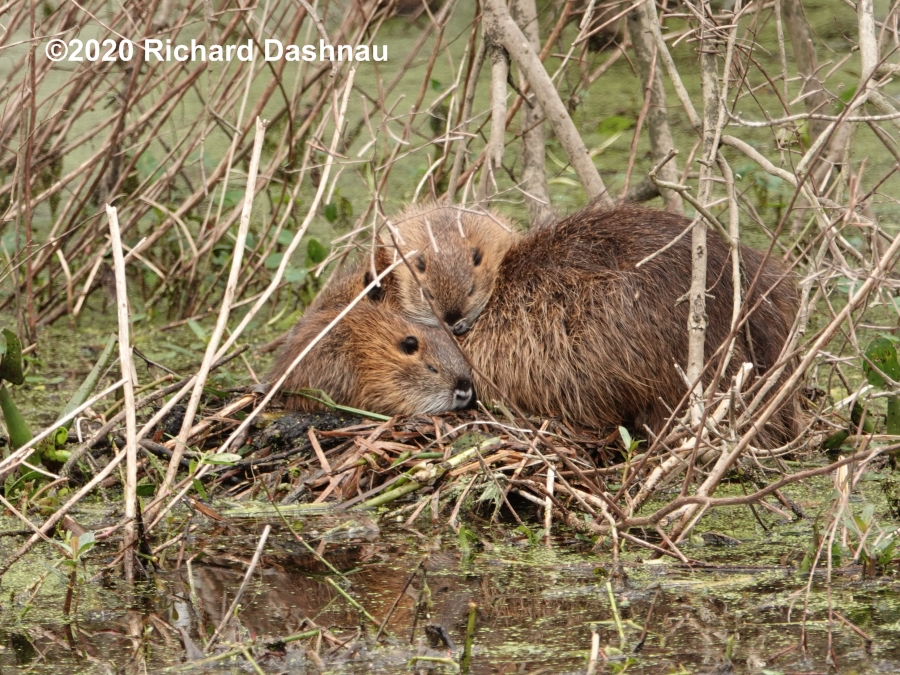
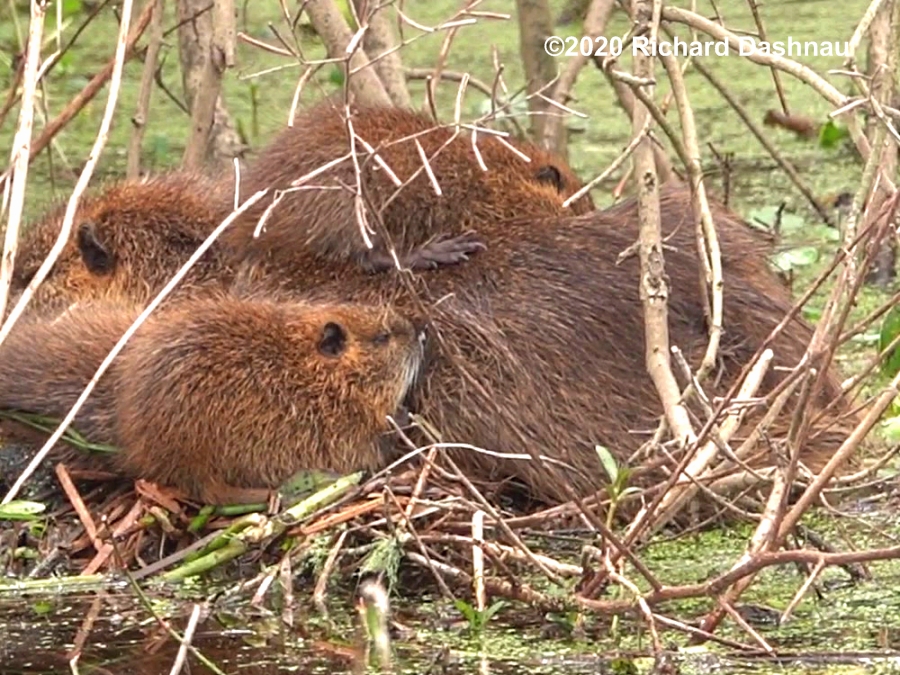
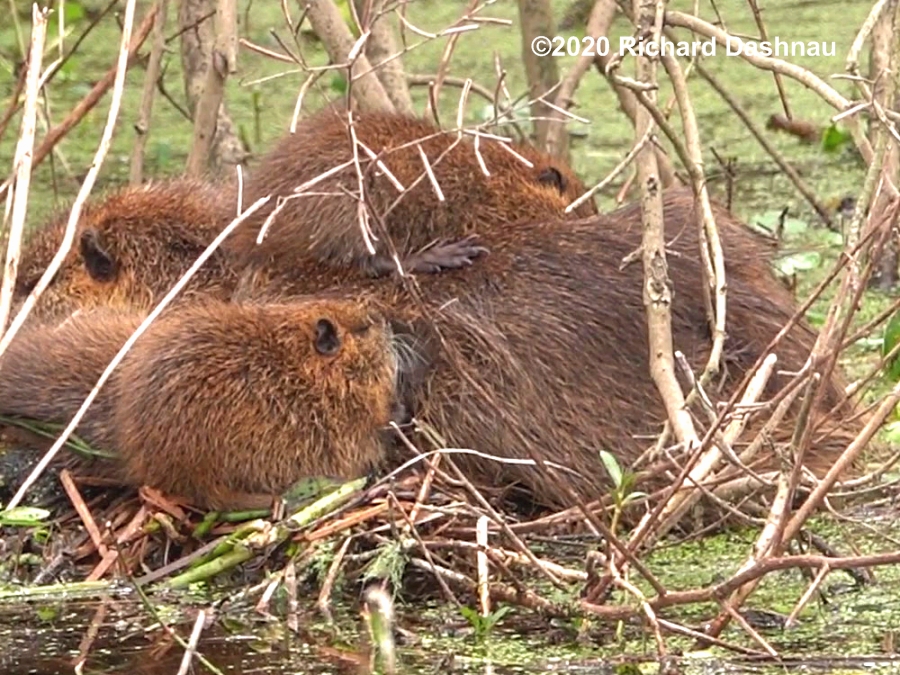
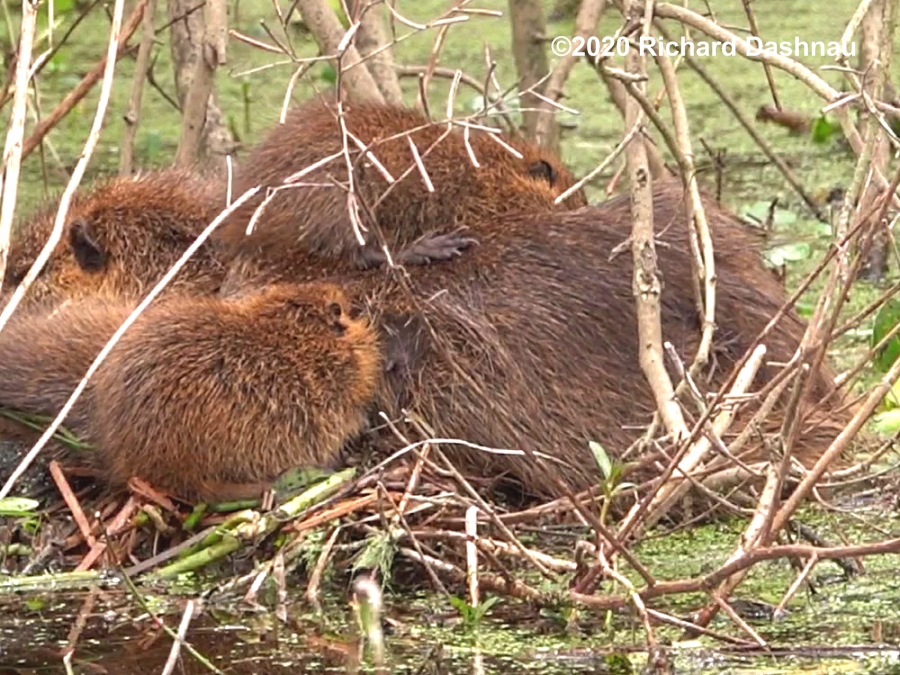
07
08
09
10
I
don't have any printed literature that gives information about
Nutria,
but I've found data online. One source that covered many
aspects of
the natural history of Nutria was:
"Nutria (Myocastor coypus) in Louisiana" for Genesis
Laboratories, Inc 2002 Link
to the PDF. or cut and paste :
https://www.aphis.usda.gov/wildlife_damage/nwdp/pdf/Nutria%20in%20Louisiana.pdf
This
is where I've found most of the data in one place. Here is some
information I got from that source that relates to the pictures
above.
Nutria
breed
often, and are ready to breed a few days after birthing a
litter. Gestation takes about 4 and a half months and
usually produces
3 to 6 babies. In Louisiana, high birth rates have
occurred in Dec,
Jan, Jun, and July. Babies are born fully furred, active,
and with
eyes open. Nutria use vegetation make large mats which
they use for
feeding, groom, and resting. Females
gave 4 pairs of mammary glands, but
unlike most mammals, these are placed on the sides of their
body. This
could allow the young to nurse with their noses above the
water's
surface while the
mom is swimming.
05/02/2019 and
06/10/2019 On
5/2/19 I was
walking with Piper along one of our streets when I noticed that
there were "excavations" in some of the
cultivated
areas in some of the yards along the street. I wonded a bit
about them,
since it was pretty intensive in some spots--was it Feral Hogs?
--was
it
Armadillos? On our way back, I had an answer. A
group of
armadillos (Dasypus novemcinctus) were foraging in the leaves.
Armadillos don't see very
well, and with the roadnoise covering
any sounds Piper or I were making, we didn't disturb them.
I
stopped Piper andwe watched the Armadillos...and they
continued
getting closer to us. I had to hold on to Pipers leash and pull
her
back a bit. Piper was very interested, and it appeared
that she
didn't know what
these creatures were. I bet that she's smelled
traces of armadillos all along-but she'd never met one. I don't
normally handle my phone while I'm walking
Piper (walking your dog
requires all your attention) but I had to catch some of this.
So, I
shot some video. The images below are from this video clip. I
stopped filming to put the phone away so I could maintain full
control of Piper. And...we left the armadillos alone.
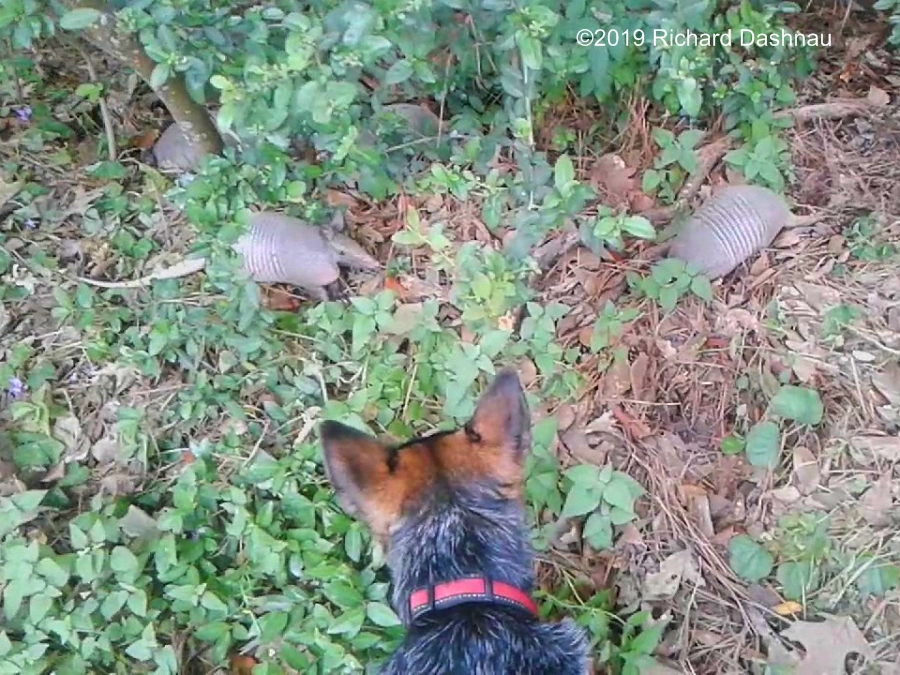
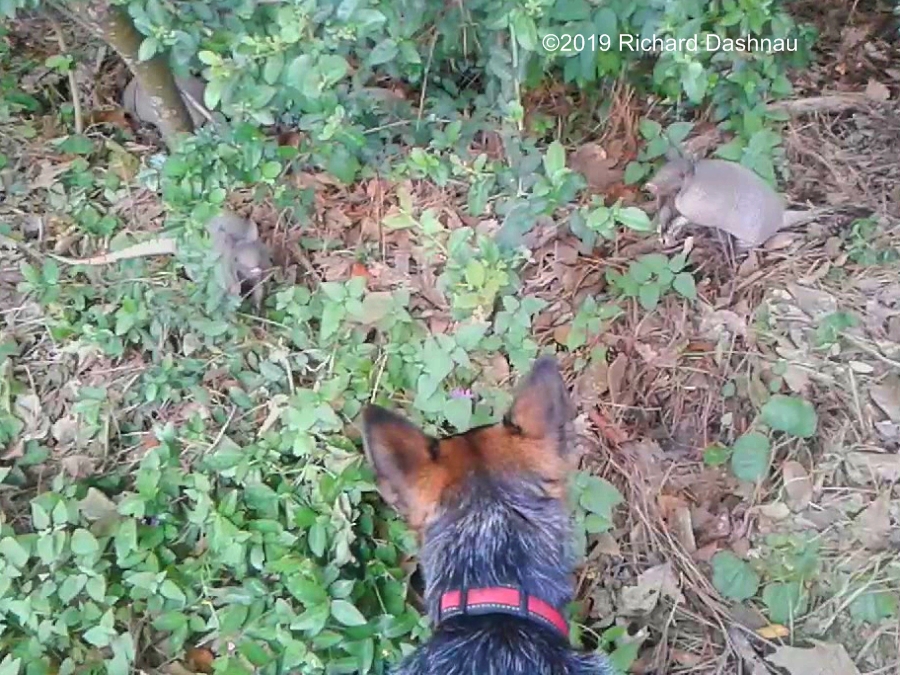
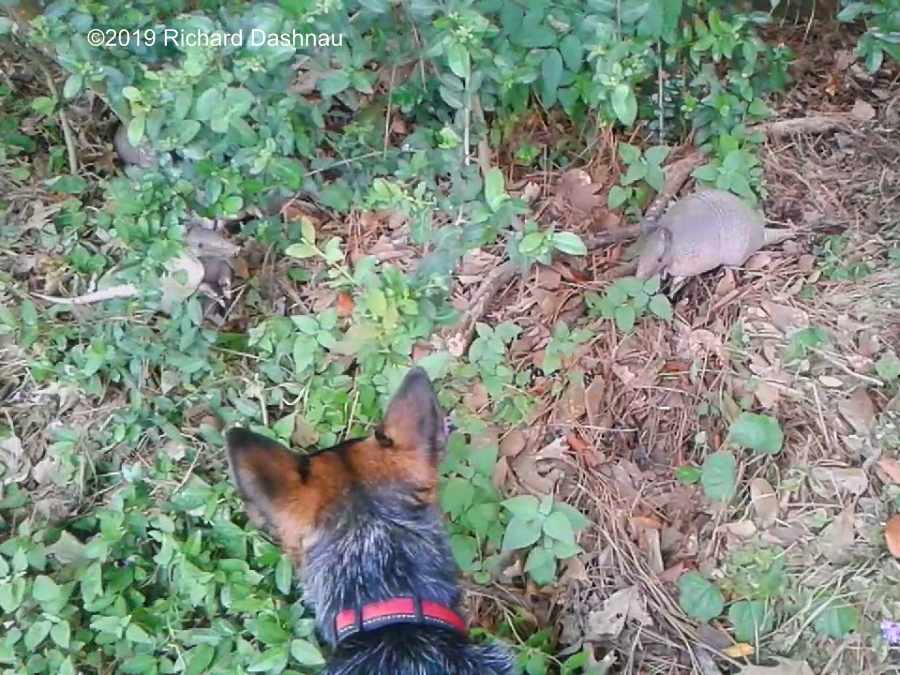
On 6/10/19
I was just finishing up my usual workout at one of our local
parks. A
group of 4 young Armadillos casually moved out of the trees and
began
foraging close to where I had been exercising. I went to my car
and
grabbed my camera. Photos didn't come out well, since the
armadillos
stayed
within cover, but the video didn't turn out badly. The
images below are from this video clip.
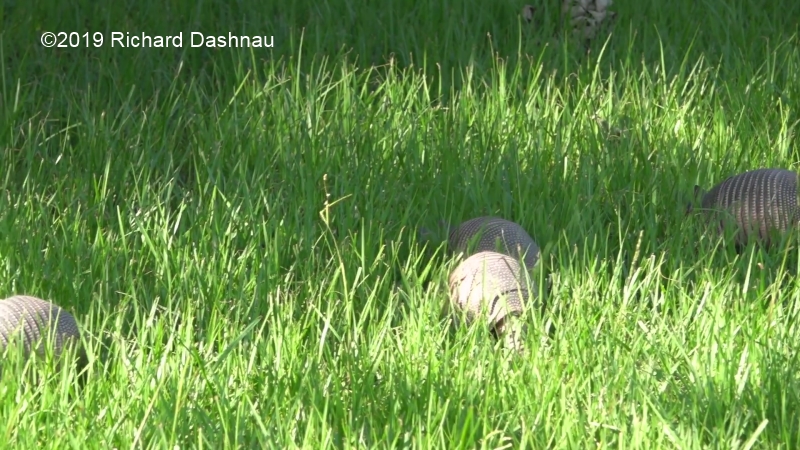
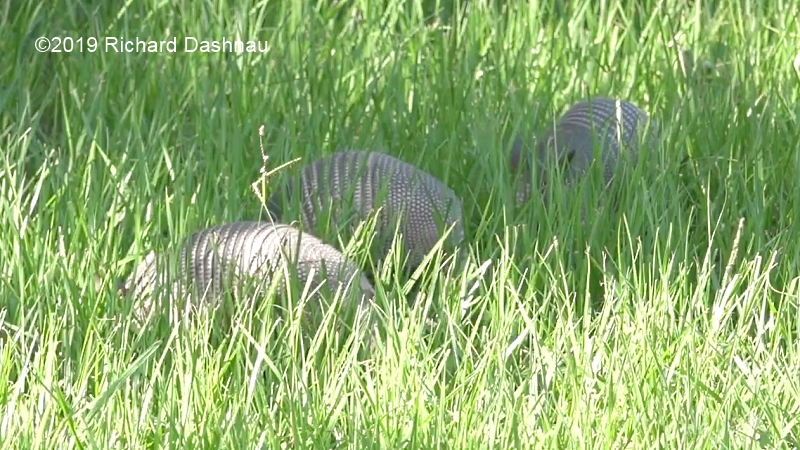
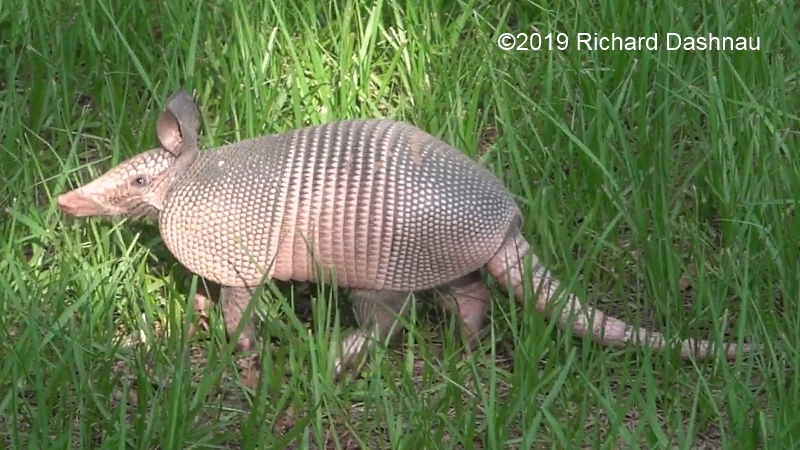
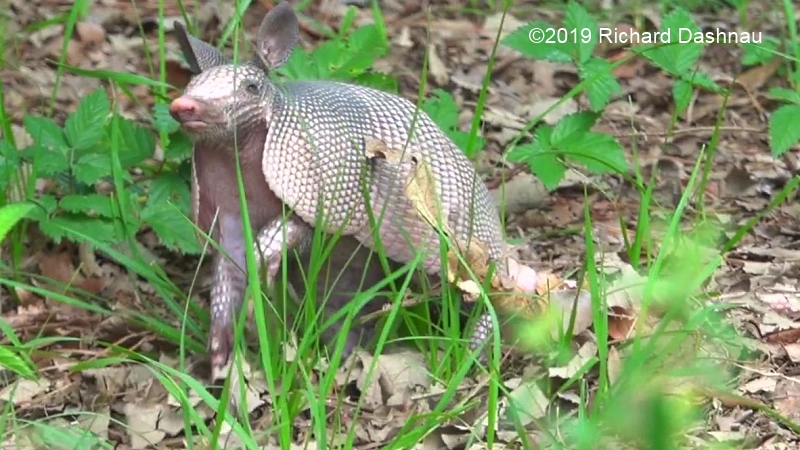
According to various sources,
including this web page: http://www.nsrl.ttu.edu/tmot1/dasynove.htm
armadillos are a fairly
recent addition
to
the wildlife in Texas. They began spreading into the state about
120
years ago. Follow the link for more information (ond/or
look at
the
video clip). I will mention one thing here.
Armadillos
usually have a litter of four "pups". This is because once
the
fertilized
egg is implanted (and this can be delayed for
months--apparently by choice) it develops into 4 identical
embryos.
This means that
4 identical quadruplets are born--that are identical
to each other. 93% of an armadillos diet is "animal
matter"-mostly insects and invertebrates.
7% is various plant
matter. A large portion of the invertebrates are beetles
and
beetle larva. Generally the armadillos dig for their
food, or push through loose litter to find it.
March
31, 2019 This
morning, there was a group of nutria on another plant mat. This
appears to be a set of 5 young ones.
The
report "Nutria (Myocastor coypus) in Louisiana A report prepared
for
the Louisiana Department of Wildlife and Fisheries By Genesis
Laboratories, Inc (2002) says that a litter of nutria is usually 3
to 6 babies; but can range "from 1 to 12 individuals." I
didn't
see any larger ones
at this time.
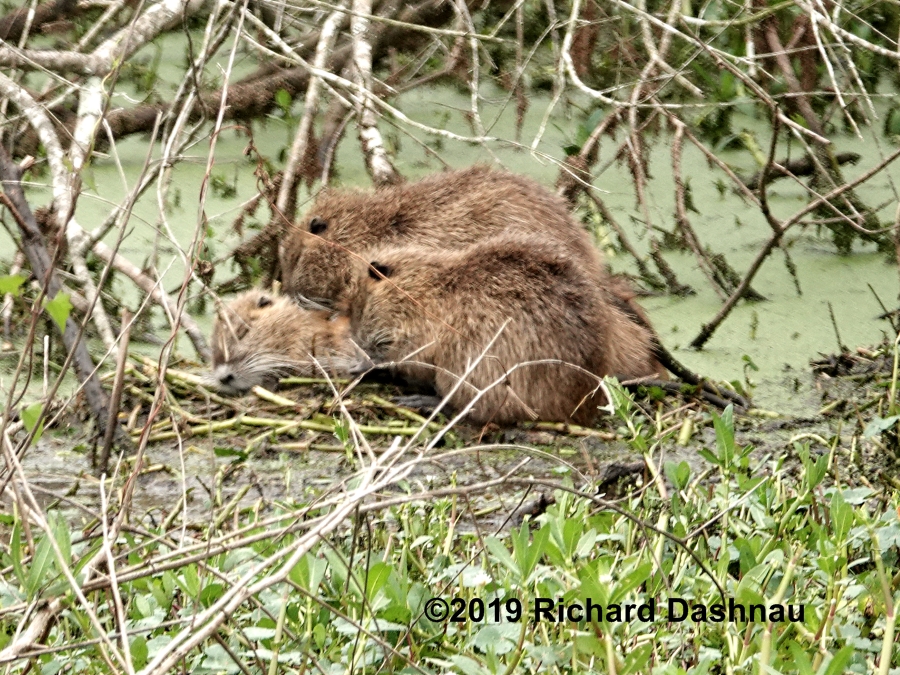
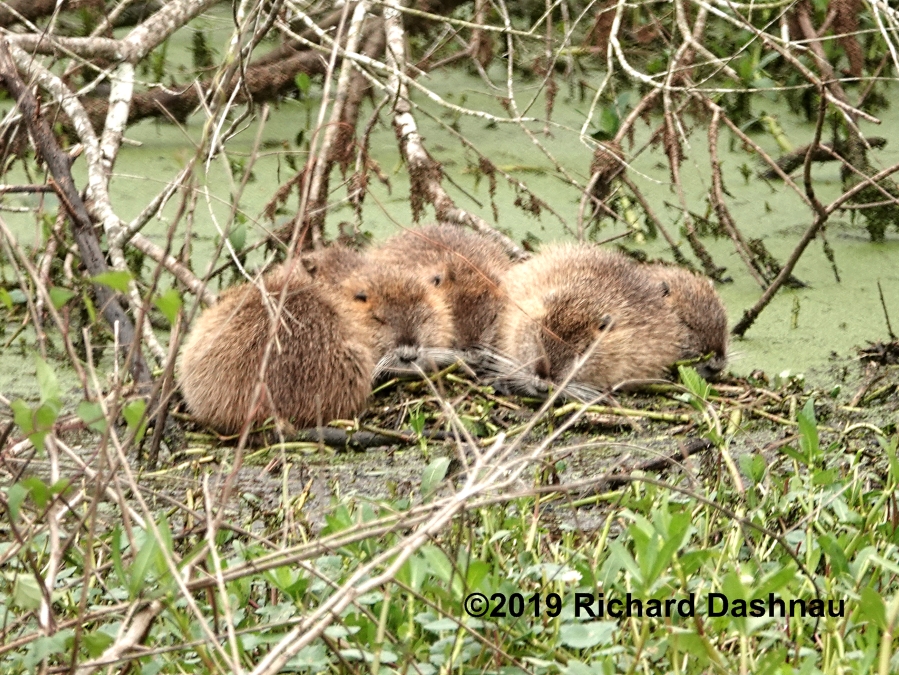
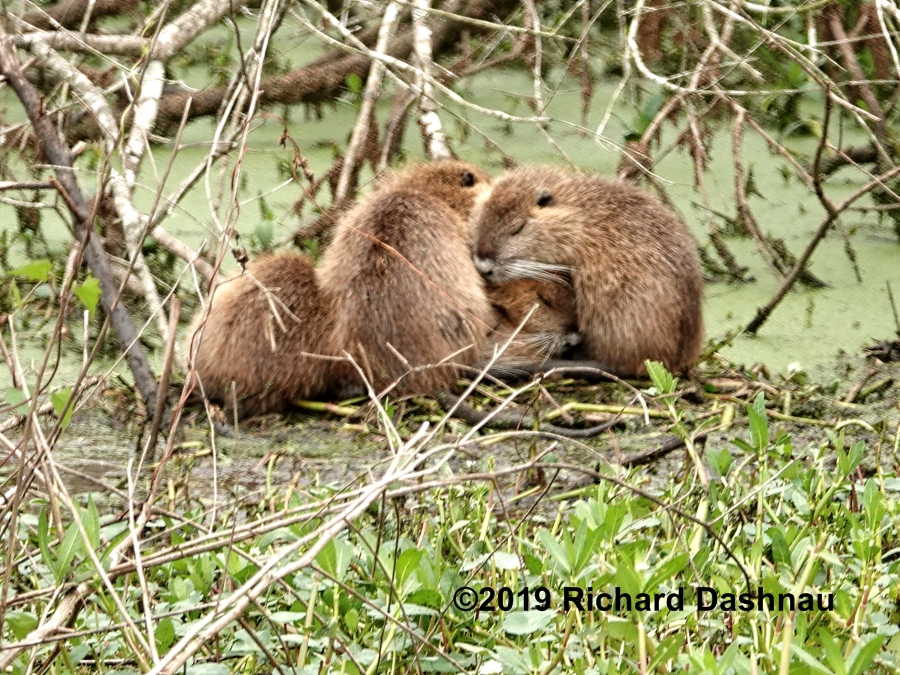
January 27, 2019 Over
the cold months, nutria seem to be more active than during the
warmer
times. This may be because the major predator of
nutria--alligators--are less active during that season. Here
is a
nutria enduring some cold weather. It's resting on what may be a
"mat"
of some kind
which it has built among branches.
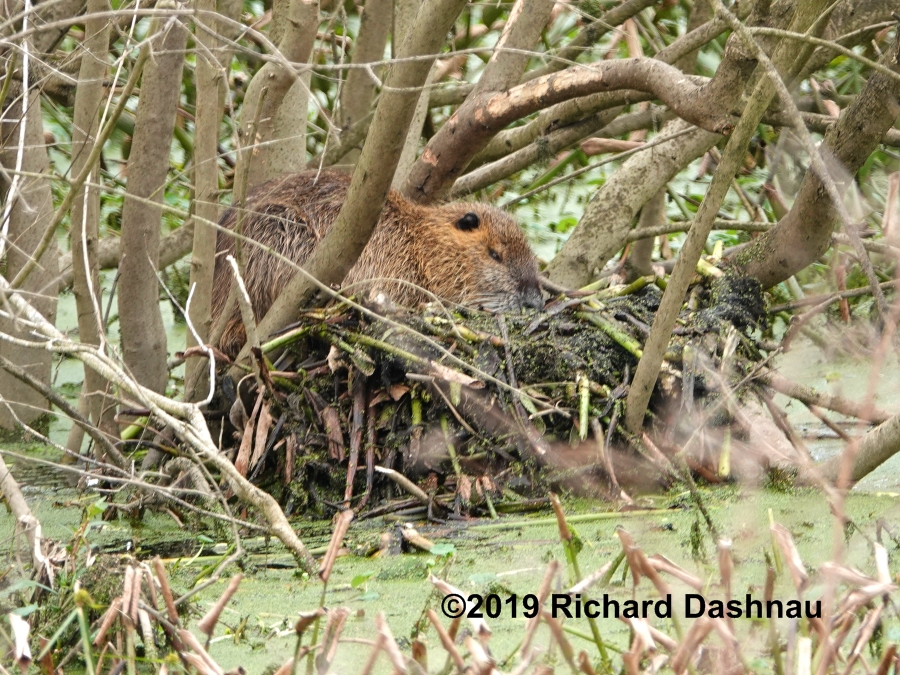
April 27, 2014 I
had just driven past Park Headquarters when 2 cats appeared and
leisurely walked onto the road. I stopped the car, and looked at
them,
and my first thought was
"BOBCATS!" But I couldn't believe that
they'd just stand there about 15 yards in front of my car. But
they
were large, and had bobbed tails, and long legs...and the color was
right.
So... BOBCATS!!
They started walking along the road, and I
decided to get the camera out. I was afraid to look away from the
cats
because I thought they'd disappear. But, they continued walking.
I
continued following in the car, driving very slowly. I took a
picture through the windshield, then shot a few video clips. I
continued driving forward to try to keep up with the Bobcats,
but I
didn't want to scare them. So, there was a combination of driving
and looking through the zoomed camera. The Bobcats finally
walked onto
the Prairie Trail. I drove until my
open passenger-side window was
next to the trail. Both Bobcats turned and looked over their
shoulder at me, then walked up the trail. I was able to get two last
pictures as they
moved up the trail.
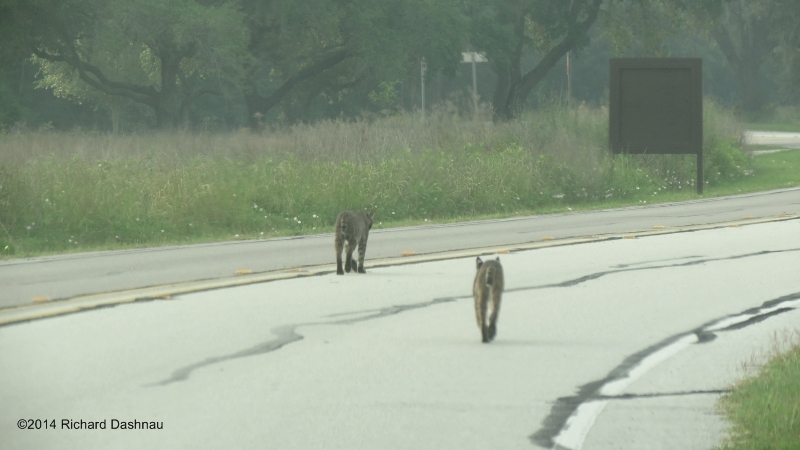
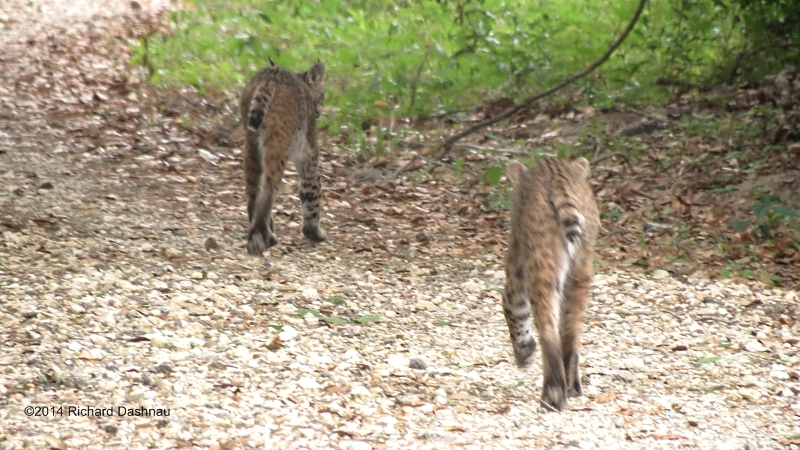
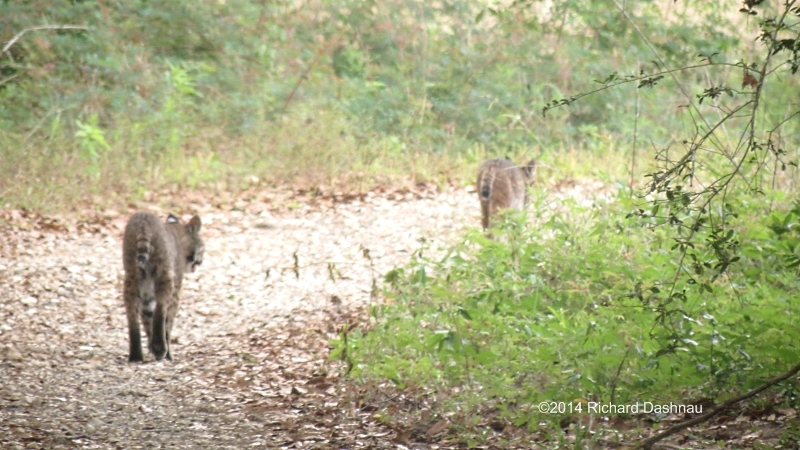
According
to information online from TPWD, Bobcats (Lynx rufus) are usually 25
to
30 inches long, stand 20 inches tall at the shoulder, and weigh
15-25
pounds. The tail is about 6
inches long. Sometimes Bobcats are
referred to as "Felis rufus". But, in the book Bobcat:Master
of
Survival by Kevin Hansen; there is reference to a difference in the
number of teeth
that most cats (felids) have compared to what Lynx
have. Bobcats and Lynx have 2 fewer teeth than Felids do (they
are
missing an upper premolar). So, it is probably more accurate
to group
Bobcats with the Lynx--therefore Lynx rufus. (page 35) They can
have a range of 5 to 50 miles, butcan travel even less if there is
abundant food. Like many predators, they will
take whatever prey is
available; including mice, rabbits, birds, fawns, and carrion.
Bobcats prefer hunting at night (their eyes with elliptical pupils
are
efficient at gathering light).
Breeding usually begins just after
January, and
2 to 7 young are born about 50 days later.
The TPWD sites are here: http://www.tpwd.state.tx.us/huntwild/wild/species/bobcat/
and here: http://www.tpwd.state.tx.us/publications/nonpwdpubs/introducing_mammals/bobcats/
The edited video is here: wmv
format 9mb mp4
format 18mb
I have more pictures and video clips of another Bobcat in
2006 on lower on this page.
September 15, 2013 I
was at the South end of 40 Acre lake. Low water levels had uncovered
that end of the lake, leaving the lake bed exposed. I noticed two
large
depressions
in the mud, and decided to go examine them. They were obviously
traces left by some animal.
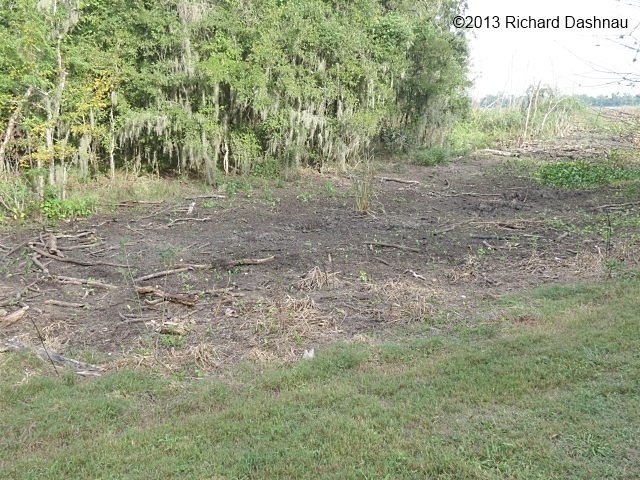
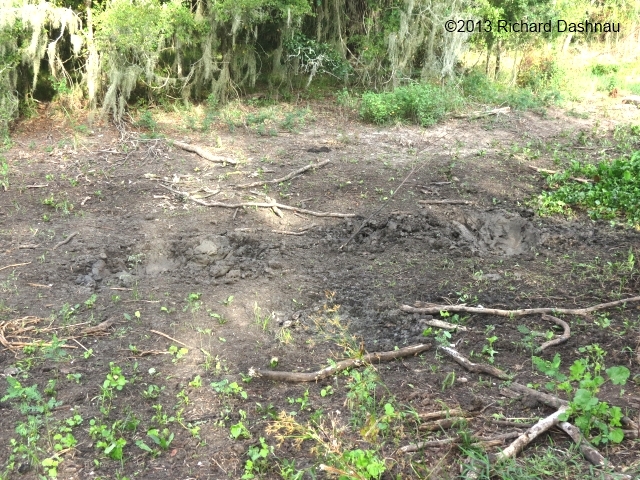
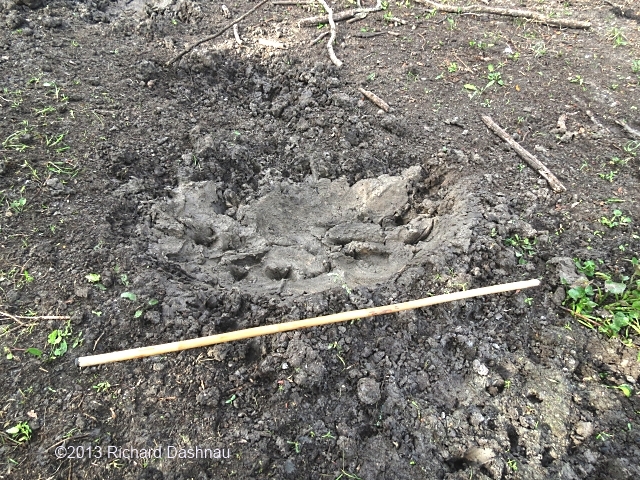
I
focused my attention on the larger depression. As shown by
comparison
by my walking stick (which is 71 1/2 inches long), the hole is about
4
feet long.
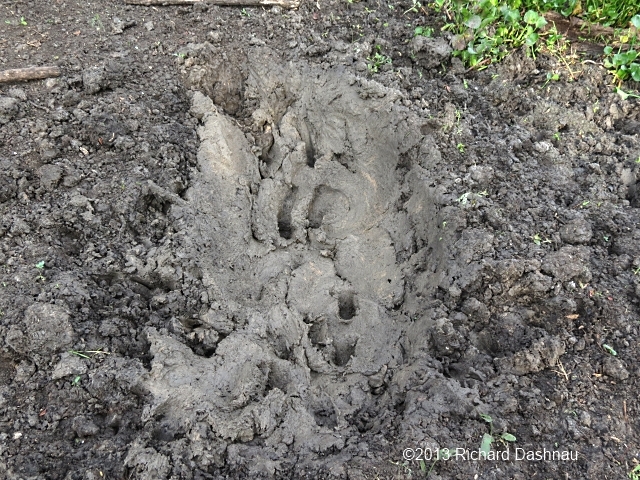
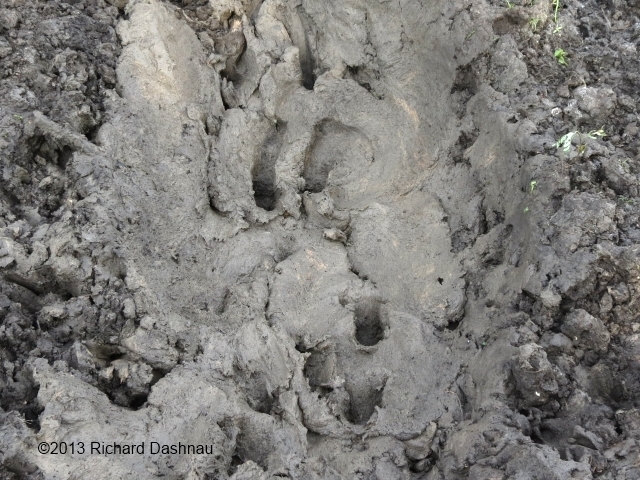
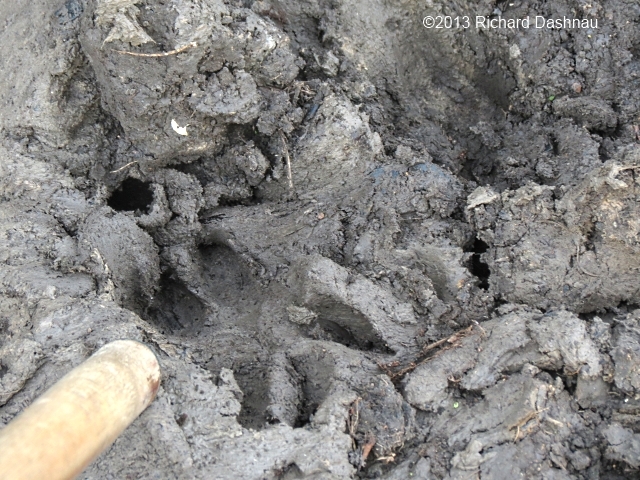
A number of marks showed in
the mud. These appeared to be footprints, most likely from a feral
hog.
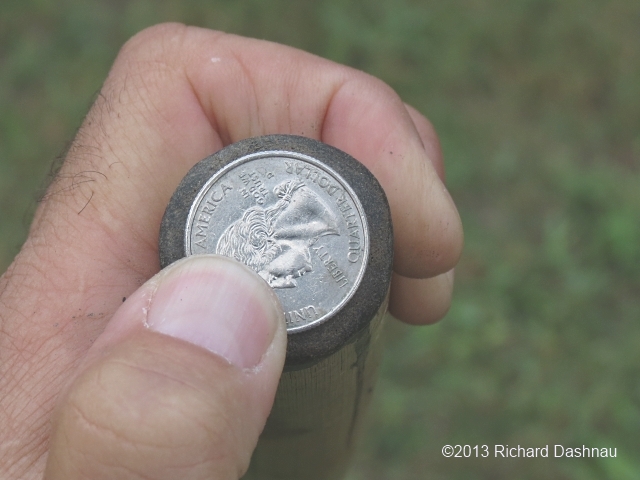
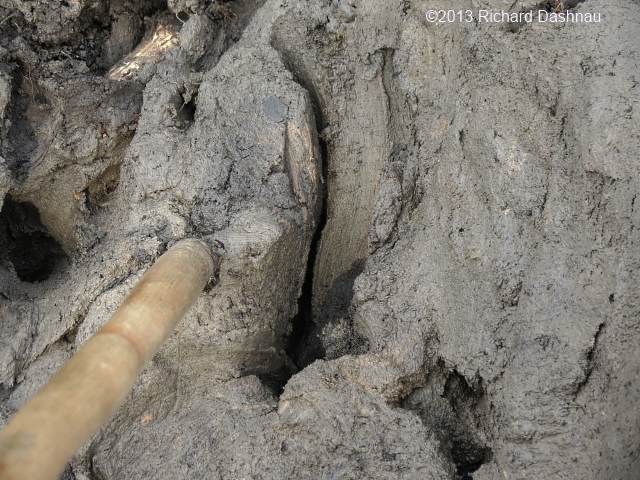
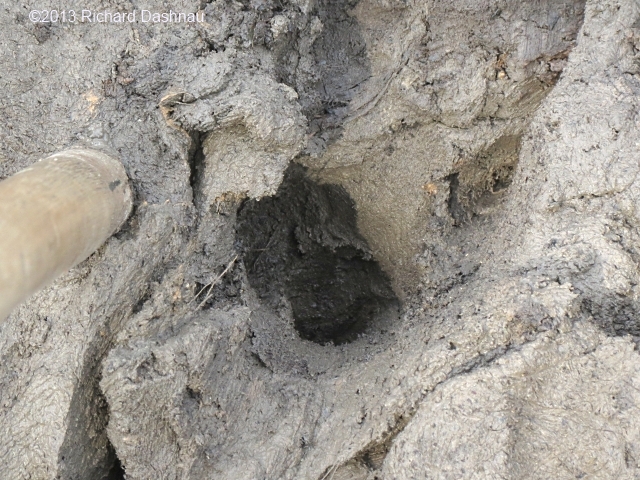
My walking stick is about
1 inch thick. The footprints, if that is what they are, are
pretty big. There are some other
marks
that I couldn't identify. By comparison alligators have 5 toes on
their
front feet (manus) and 4 toes on their back feet (pes).
Here's an example of my hand
with the pes impression of a large alligator.
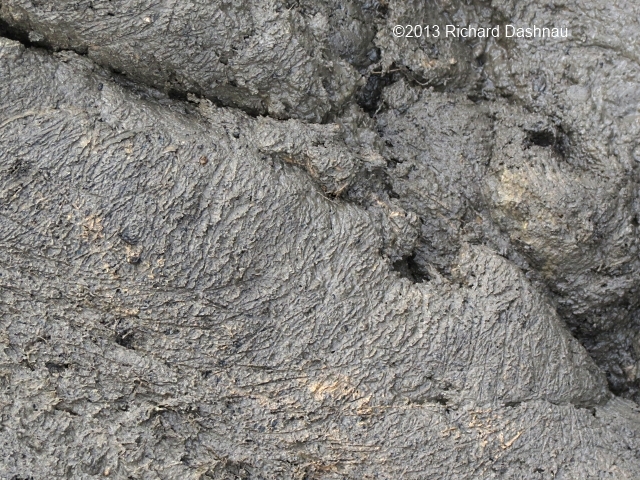
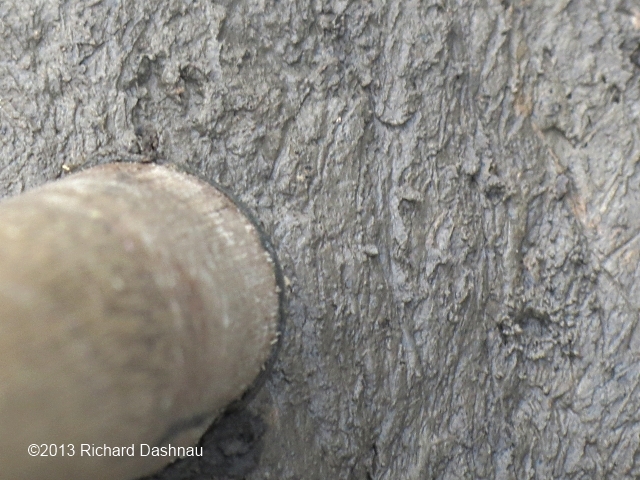
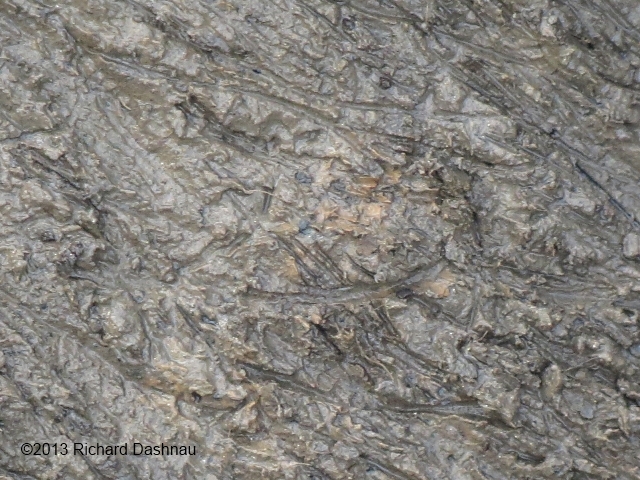
But what I thought was the most
interesting thing about these traces was the numerous "scrapes" in
the impression. I believe
these are impressions of the hog's fur!!
The
study of animal life traces is called "ichnology". That is,
the
changes in the environment left by living animals. The
three "pillars of ichnology" (according to Anthony Martin in his
book Life Traces of the Georgia Coast) are:
1) Substrate -the material which has captured the life traces
2) Anatomy - the parts of the animal which have altered the
substrate
3) Behavior - the actions done with the anatomy to leave marks on
the subtrate
Ichnology can be studied in living organisms (neoichnology); or
ancient organisms (paleoichnology).
July
01, 2012-- Today
was
overcast with sporadic bouts of wind and rain. With weather like
that, I didn't expect to have any takers for my Creekfield hike, but
one never knows.
It turned out that I had a few takers, so we toured the Creekfield
trail.
As
we were coming around the last length--the portion nearest the Nature
Center--I noticed a fawn walking on the trail about 50 yards ahead of
us. We stopped, and I shot a few
pictures. Then, we slowly moved
forward. I wanted to see if we could get closer to the fawn. We really
could not, but it didn't run away from us either. We'd move a few
steps,
and the fawn would move a few steps. As we crossed the wooden bridge,
I
lost sight of the fawn, and it was out of my mind when we got to the
"sapsucker tree".
We got back to the trail intersection, I turned right to go back
towards the Nature Center...and there was the fawn.
It
was near the road, to the left of the trail. We tried again to move
slowly towards the road, but I took us off the trail and into the
grass
on the right to give the fawn room.
A few seconds later, I noticed a
rabbit next to the fawn. For many of us, the image of a fawn conjures
up the name Bambi--and the character. Well, I was not only looking
at
Bambi, but apparently Thumper was visiting as well. As we slowly moved
towards the road, some other visitors on the opposite side of the road
also had noticed
the fawn and rabbit, and were moving towards them.
This spooked the fawn a bit, and it moved deeper into the trees. We
crossed the road.
--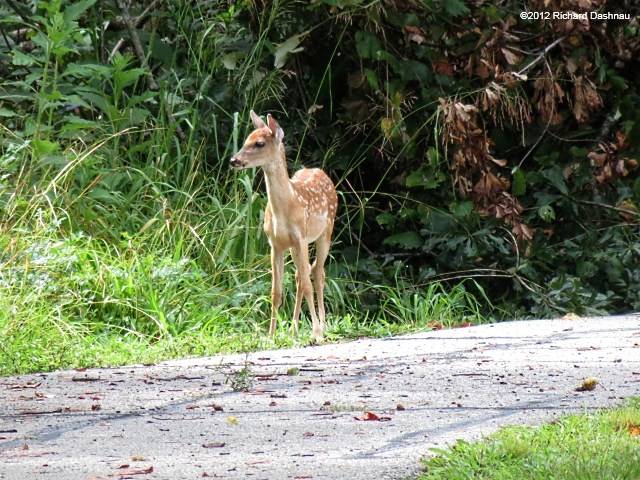 --
--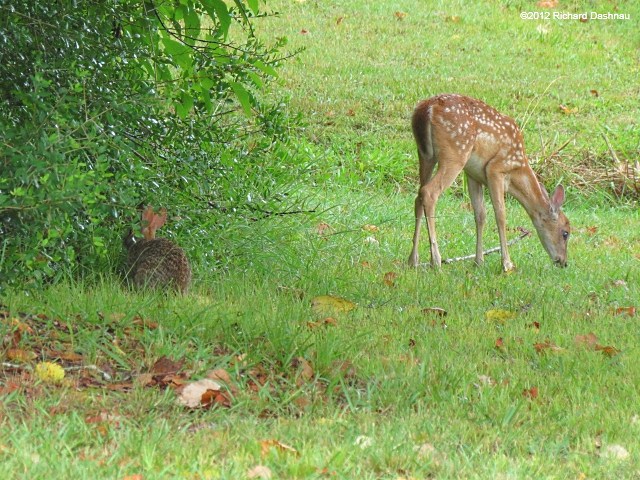 --
--
About
2 hours later, I was leaving the park because of the overcast weather.
I decided to drive around the park a bit first. I turned the car
towards the campsites,
and there-in the field by the Creekfield
Trail-was the fawn. It was resting comfortably. And off some
yards to the left was a doe--most likely the fawn's mother. I drove by
a few times
and shot some video and some photos. The doe wasn't close to the fawn,
but I tried to get them both in at least one shot.
And then another patch of rain came, so it was time to go.
I enjoyed our visit with the fawn. I wondered at the lack
of panic on such a young deer. But, its mom was nearby.
--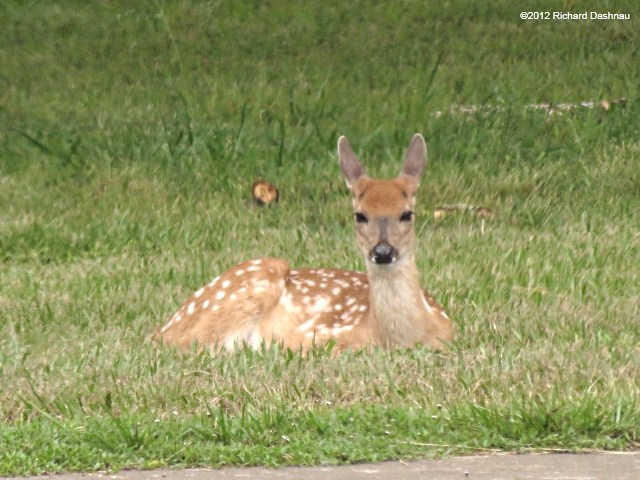 -
-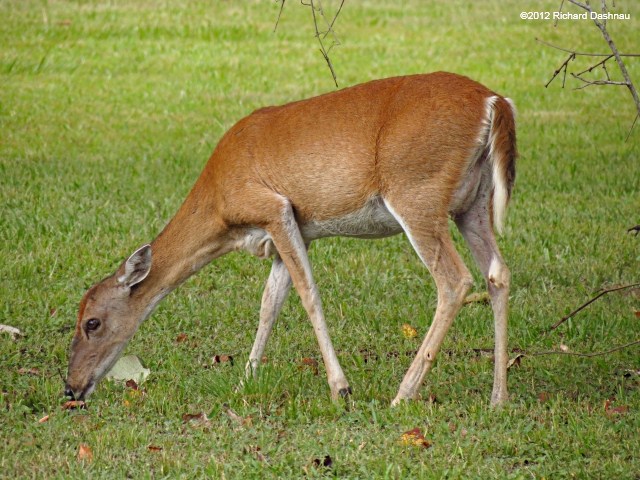 -
-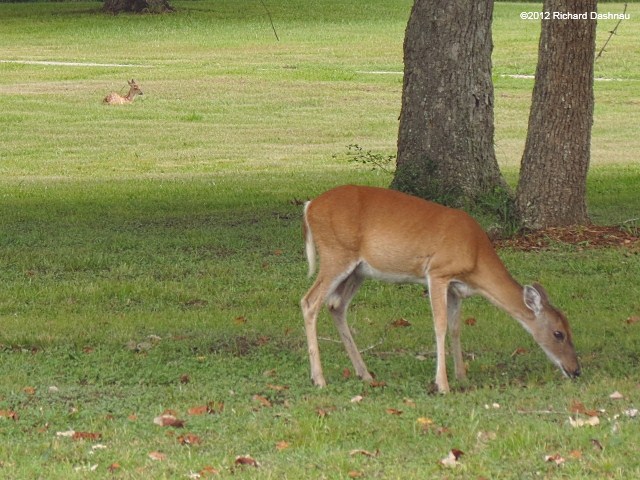 -
-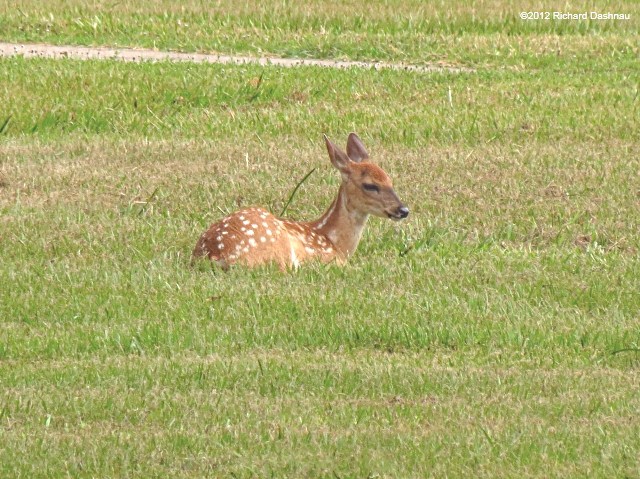
April
24, 2011:
It was another busy Easter
at Brazos Bend State park. However, before the big rush started, I got
to hear a chorus of alligator bellows at about 8:30 am. I spent most
of
the day
riding around the lakes, and educating park visitors. I got
word that a fawn was visible from one of the trails. A doe will
sometimes leave a new fawn in a protected spot for a while. This fawn
was
in a good spot, across the water from the trail. Today's
RICKUBISCAM is cropped from one of the pictures I shot. While I was
watching the fawn, the clouds moved away and the sun came out.
When it
did, it shined through the trees onto the fawn, making this wonderful
image. The fawn slept peacefully through the day, at least it seemed
to
be fine whenever I passed it (and I passed it
many times today).
Below is a larger version of the image.
---------------------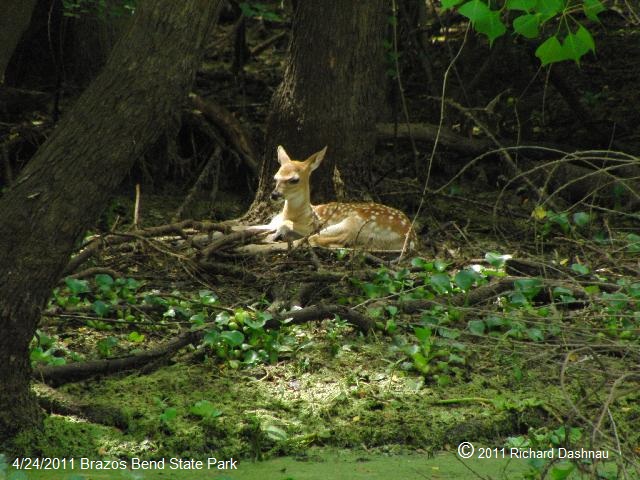 --
--
2/18/2007-- (added to this page
from old material 1/26/2022) Sunday was
a beautiful day. I made my way to new horseshoe lake where I found
an medium alligator (about 9' long)
on
the back side (past the bench) with some kind of mammal in its jaws.
The fur was kind of coarse, and the animal seemed sort of long. I
spent
a little over four hours watching and
waiting for the alligator to
move the carcass enough to let me see what it was. Considering how
cold
it's been during the evenings, it's surprising that an alligator is
eating anything,
including
something this large. I don't think there's any way to tell what
happened, or even how old the carcass is. The alligator could have
found it. The alligator could have killed it.
With weather
conditions as they've been, it's concievable that the carcass could
be
many days old, with the equivalant of being placed in a refrigerator
every evening.
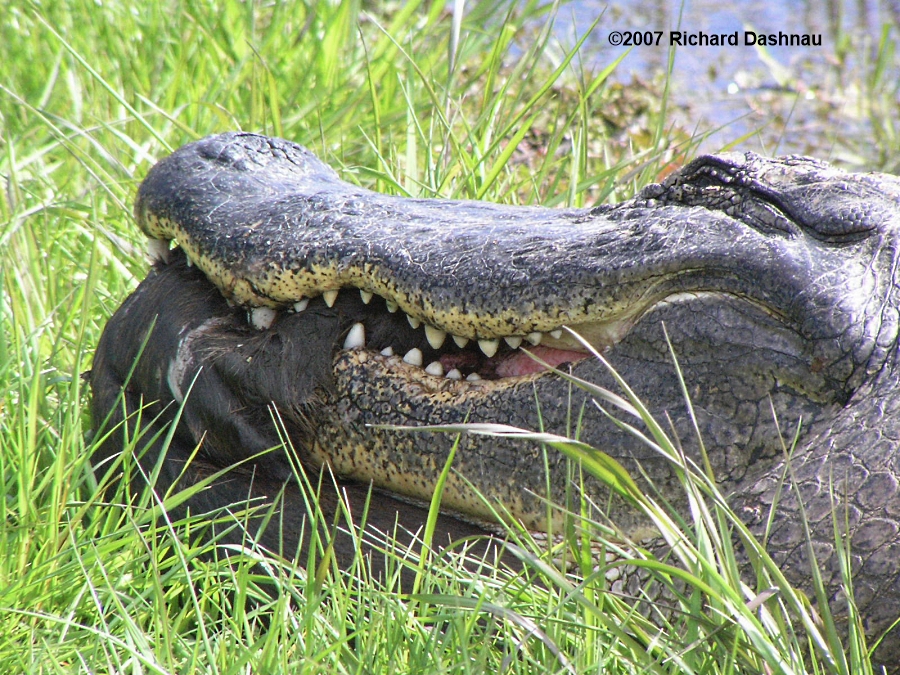 -
-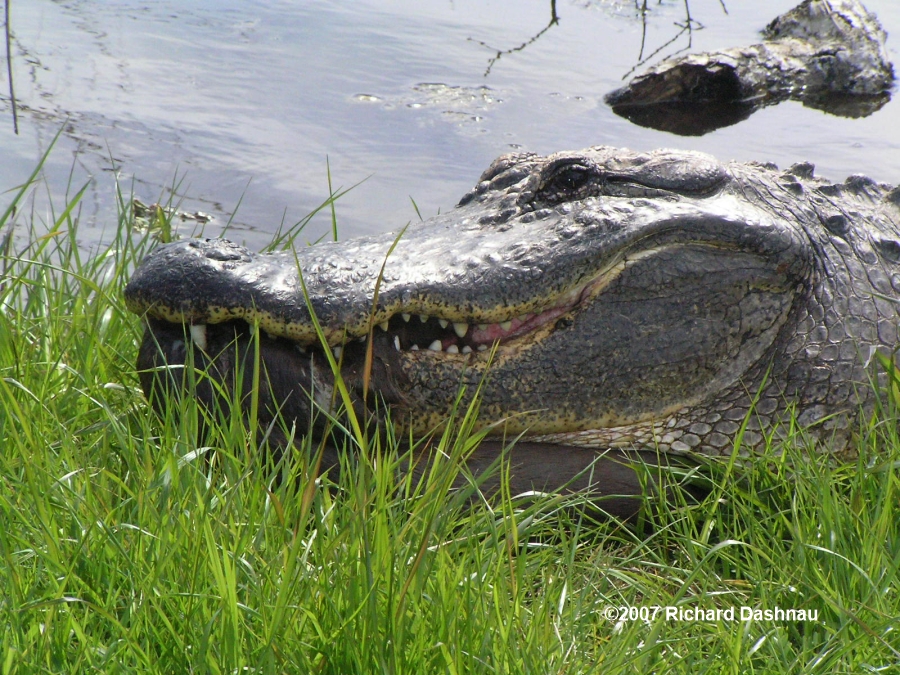 -
-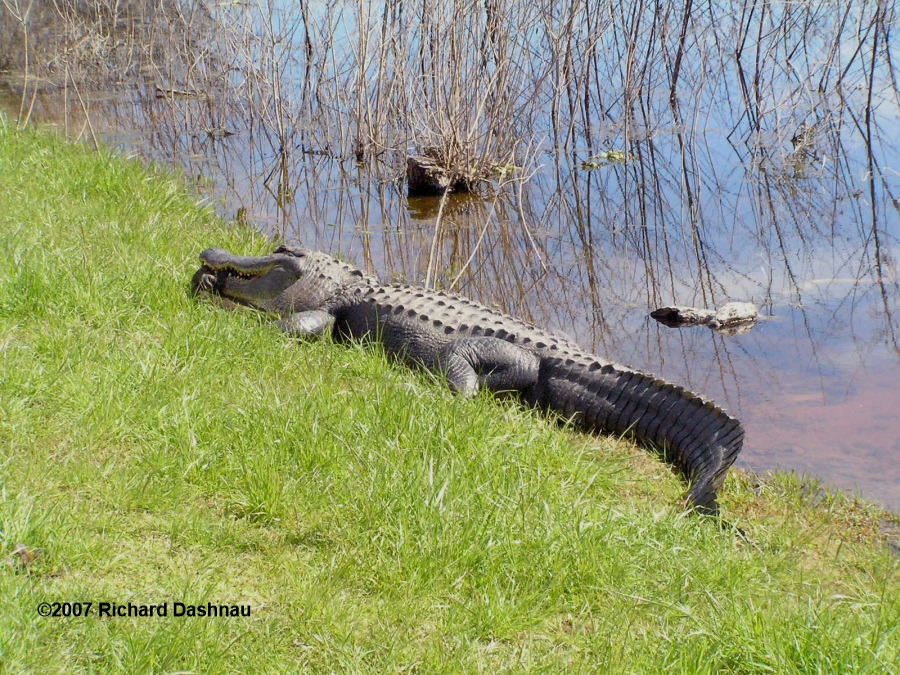 -
-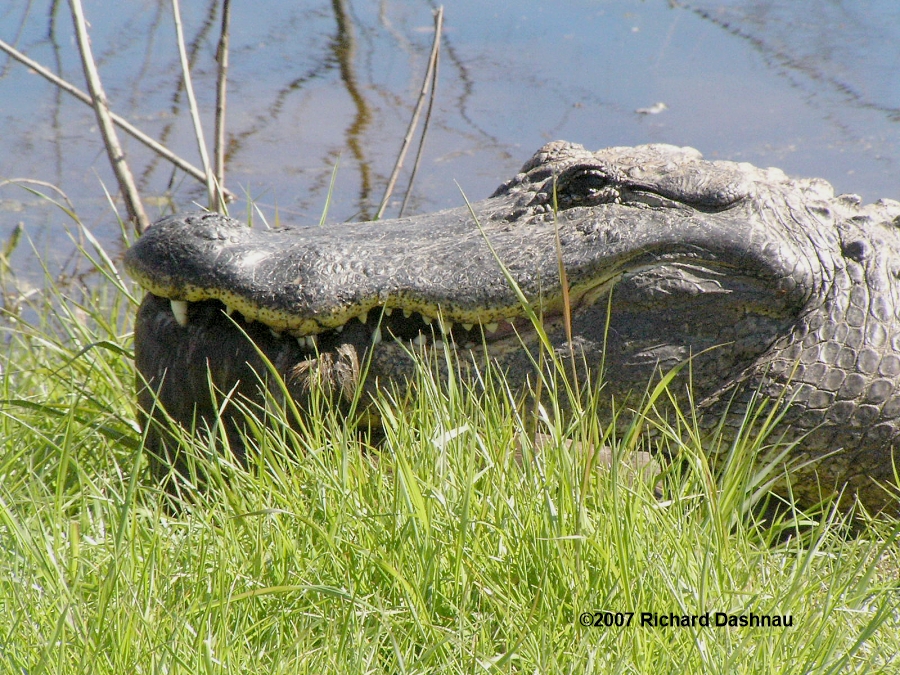 -
-
During
all that time, I got a chance to interpret for many park visitors.
Sometime in the mid afternoon, as I was describing what I thought
the
furred creature probably was
(a nutria)
and what I hoped it wasn't
(an otter), a couple park visitors nearly knocked me out with this
set of statements: "An otter? We just saw one."
And
I asked where. And they told me. It was down on the Spillway trail,
on
the island which I propose be christened "Otter Island". Of course,
I
gave my usual congratulations and
explained that that's a rare event. Later, some other
visitors also reported seeing the otter, and a few stated that it
was
just lying around on the island. I just had to get out there!
But I couldn't leave. I hadn't found out what the alligator was
holding yet.
Finally,
the alligator moved forward one more time. In over 4 hours, it moved
its feet a few times, lifted its head and grunted thrice in a row,
slid
forward about one foot, then shifted
forward again about a
foot. That's it. Well, unless you count opening and closing its
eyes. Through my binoculars, I saw a broad, flat, "scaly"
tail. The dead mammal was a beaver,
and
the
alligator had it by the head. After the last few visitors
cleared
out, I hustled over to look for the Otter. And the story continues
on my
otter page.
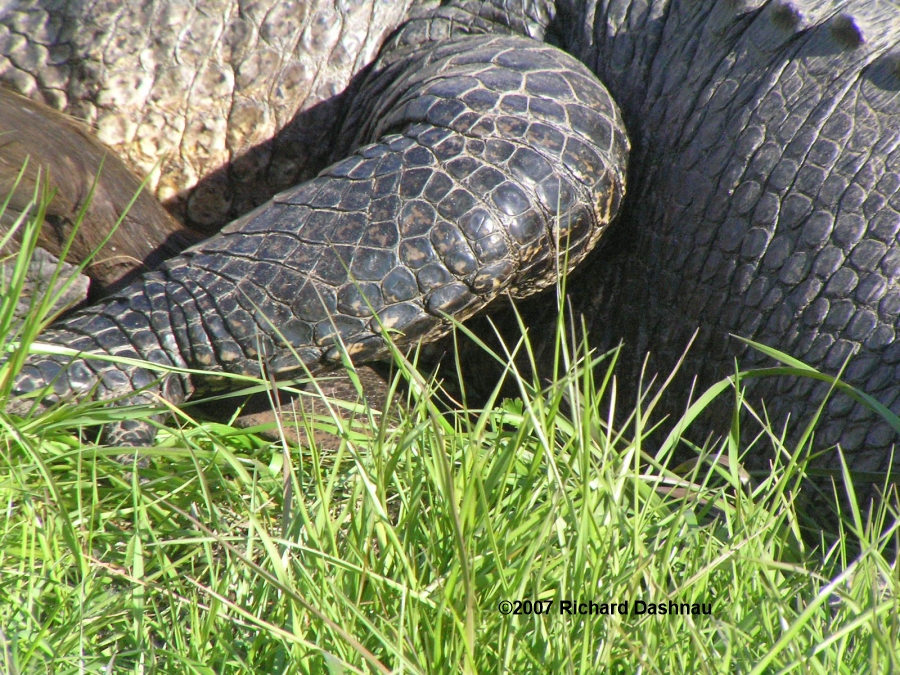 -
-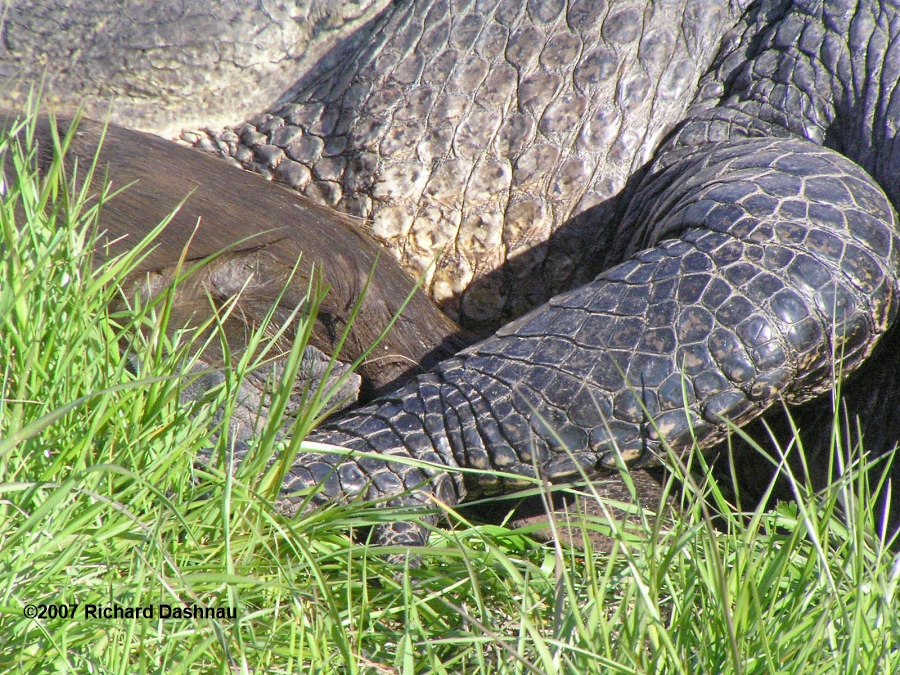 -
-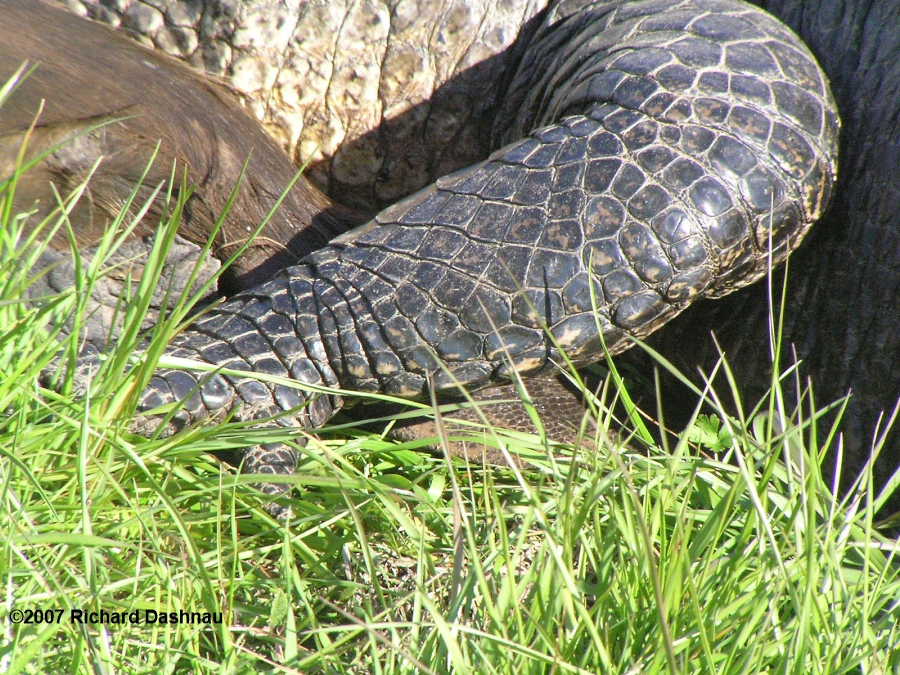 -
-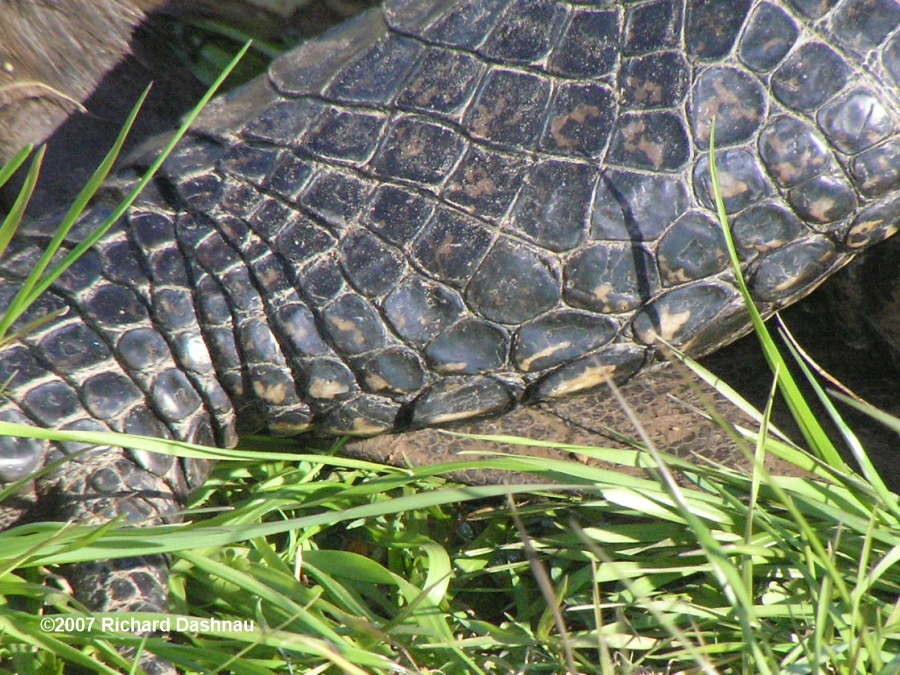 -
-
THE
MYSTERY REVEALED
A BROAD, FLAT
TAIL
THAT'S NO NUTRIA
A CLOSER LOOK AT THE TAIL
March
12, 2006,
The
image below is from one of the photos I took with my digital still
camera
at Brazos Bend State Park.
-------------------------------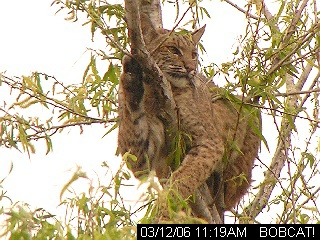 -
-
Some
of you may have heard about the bobcat that we got to see by the
Spillway
Bridge at Brazos Bend State Park on March 12.
This
is my story:
I met
a couple walking on the North part of the 40-Acre Lake trail at
about 9:00
AM. We talked for a while, and they mentioned
that
they'd seen two bobcats fighting over by the Spillway Bridge, and
that
one was still over there. I hastened to the bridge, and
spent
about 10 minutes walking back and forth on the bridge--scanning
both sides
of the bridge--and looking through the
undergrowth
for a cat skulking in hiding. When I didn't see one, I was a bit
disappointed.
As I was resigning myself to this, two regular park
visitors
came up on bicycles. As we were talking about various animals,
etc.; I
looked back towards the bridge, and UP.
I noticed
a dark mass at the top of one of the trees. Scanning through my
binoculars
I identified the bobcat. My jaw dropped, and I
spoke
aloud the term for the male offspring of a canid female; and then
said,
"THERE'S
the BOBCAT!"
We hustled
over there.
...And
I remained there for about 2 and one-half hours. Word of the
bobcat spread
like wildfire amongst the visitors and park staff.
I'd
set up my video camera, and it has a pretty nice screen that
people passing
by can look into. The camera has a 25x optical zoom, so
that
was ok. Other Park Volunteers brought out a spotting scope, and at
that
range (I doubt the cat was more than 50 feet away) you could
have
counted its whiskers through the spotting scope. During those
hours, the
bobcat would lie still, apparently trying to doze; but
occasionally favoring
us with
baleful looks as if wishing we would all leave.
Bit
by bit, it moved from one branch fork to another, lower one. It
would try
that spot for a while, then move to the next lower one. Finally,
it made
the
last
leap, and was gone in the rice.
The series
of images below were shot with my still camera. It's an Olympus
C-770 which
had a 1.7 tele-adapter on it. The light was constantly
changing,
which is more obvious in the video
clips further below, and this made taking
pictures and video a bit difficult. In a situation like this (one
not likely
to be repeated), I just shoot as many pictures and video clips as
I can.
Hopefully
some of them will come out. Even at the the relatively short
distance involved (somewhere around 50 feet), my camera just
doesn't have
the reach to give large, clear images. However, I
could have done far worse
than the pictures I did get. I can really clear them
up if
I present them at the small resolutions I use on these
pages. I could
look at these pictures--and watch the
video--over and over again (and I
have!). What a beautiful animal! Click on the images to see
the 320
x 240 version of them.
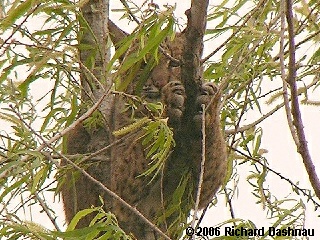 -
-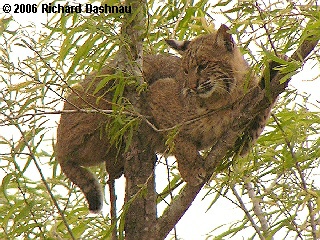 -
-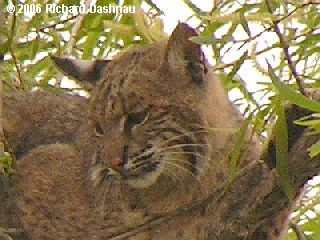 -
-
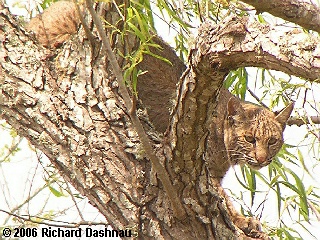 ----
----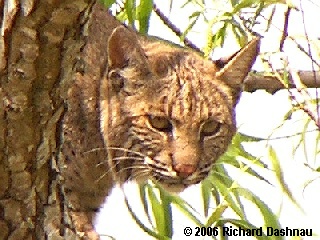 -
-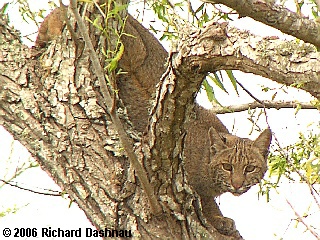 -
-
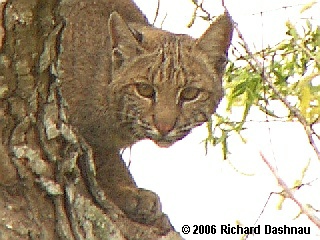 -----
-----
The
series of images below are single frames from the video clips
linked below
them. Clicking the images will show a slightly larger one (320 x
240)
and
clicking the links should show you the video clips. The
clips show
how windy it was that morning. In fact, during one of the Bobcat's
moves,
a huge gust of wind blew my camera and tripod over,
and blew the sunshade
covering it inside-out.
The
Bobcat dozing up there, propped in that unlikely position, seemed
strange
to many observers. I was impressed by the balance showed by
the
Bobcat
both while sleeping (amazing!) and while it moved. I've left the
audio
track intact in most of these clips. The sound of the wind is
evident,
but it's also fun hearing some of the wonder in the
voices of the other
people watching the cat. This Bobcat was estimated to weigh about
25-30
pounds.
-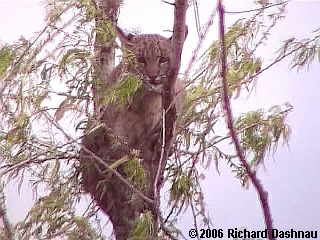 -
-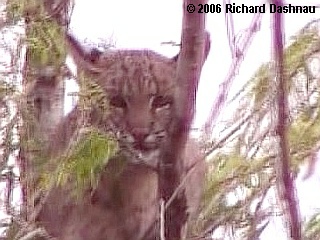 -
-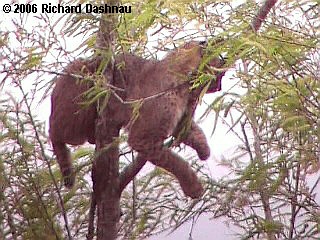
FIRST
VIEW wmv 3760kb
FIRST
VIEW,
CLOSER 3766kbFROM
ANOTHER
ANGLE 1154kb
BIT
OF A STRETCH 3404kb
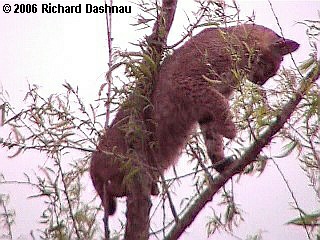 -----
-----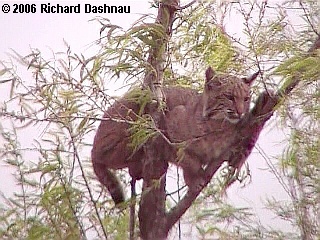 -
-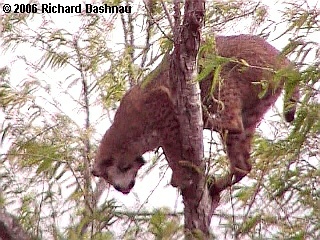
BIT
OF
A STRETCH 3404kb
THIS
IS COMFY? 560kb
TIME
TO
MOVE 2504kb
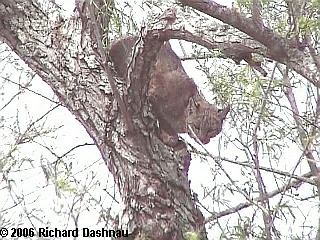 -
-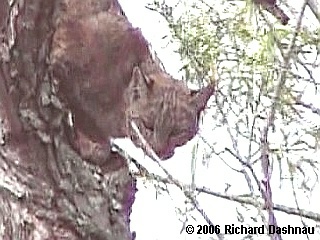 -
-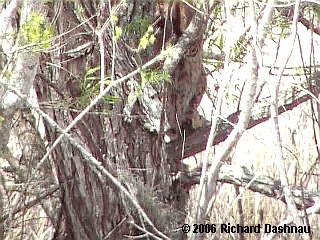
A
BIT LOWER 2604kb
A
BIT LOWER, CLOSER 2673kb
TIME
TO GO 3448kb
Although
many people (including me) find the sight of a carnivore hunting
interesting,
these moments of watching a predator in repose are also very
special to
me. The Bobcat ( Felis (Lynx) rufus)
is one
of three (according to the book North American Wildlife, by David
Jones)
native wild cats remaining in North America. The other two are the
Mountain
Lion (Felis (Puma) concolor), and the
Canadian Lynx
(Felis (Lynx) canadensis). The Bobcat's size
allows
it to maintain its range more successfully than the larger
Mountain Lion
because this allows for a greater variety of possible prey
and habitat
to hide in. I believe that the large number of Nutria in the area
where
we saw the Bobcat (with lots of young Nutria around) may allow the
cats
to feed well right there. As I watched, I
realized how lucky I was
to spend a few hours near this wild cat; a species which
has been
able to continue to thrive in our changing environment.
As an
environment changes, this can put pressure on animals and plants
living
there. Fortunately, when organisms reproduce, the offspring are
not exact
replicas of the parents. Sometimes a
"newer" model offspring may
have characteristics that allow it to survive more efficiently in
the changed
environment than the "older" model (which would include some of
its siblings
and others in its
generation, as well as the parent generation). Surviving
more efficiently means that less energy is expended on the basic
survival
needs--like finding enough to eat and not being eaten. This
can
leave more
energy available for other tasks, like reproduction. More
efficient organisms
(the "newer models") would tend to reproduce more than the "older
models"
and eventually the "older models"
could be phased out entirely. Or, small
populations of the older models could exist in areas that were
still favorable
to them (if any such areas can be found in time), while the "newer
models"
could
exist at the same time, elsewhere, in the changed
environment.
Organisms that can evolve new behaviors or physiological changes
at a pace
with their environment as it may change will survive.
Those that can't
change quickly enough--perhaps because of slow or reduced
reproductive
rates--will die off. The Bobcats seem to be doing well so
far.
This
was one of those really rare events at
the park, and I was happy to see
it. It was LOTS of fun seeing and hearing the excited visitors ,
park
volunteers and staff.
I'd
like to take this opportunity to thank Dr. Steven Orzack, of the
Fresh
Pond Research Institute (www.freshpond.org), for his editorial
comments
regarding this article and for our correspondence
in general. He
happened to be visiting BBSP for the first time on the 12th and
also got
to see the Bobcat "in person". Talk about LUCK! Thank you
for the
support, Dr. Orzack!
One
more thing. Any mistakes in spelling or grammar are mine.
ALL mine.
August
24, 2003This
morning, I was at the park, and heading up towards the VC/NC
(Visitor Center/Nature
Center) from Elm Lake when I saw a small group of raccoons off to
the side
of the
road. I stopped to take a few pictures, and when I did, they
advanced
towards the car. There were about six of them, and one stayed back
off
the road; but the others came right up to the car.
One larger one
(I assumed an adult, while the others were juveniles, but I'm not
sure)
not only approached my car on the open window side, but it stood
up, and
seemed to be reaching for the
door handle! Danged masked thugs! (see
the picture, NOT A HAPPY TREE FRIEND, below.)
Folks,
this is TERRIBLE behavior for animals that are supposed to be
wild. It's
dangerous for all life forms involved, and is caused by park
visitors (or
other irresponsible people) giving food to the
raccoons. The raccoons could
have easily been run over if a car came from the other direction.
I had
to beep my horn repeatedly to get them to move from under my
car
so I could drive on. These
raccoons aren't tame, either. Hand feeding
them is only inviting a situation where a human can be bitten or
attacked.
If the raccoons become a nuisance they will be removed from the
park (and
NOT RELOCATED ANYWHERE! GET IT? ). Here is how the term
"nuisance"
applies to raccoons: Raccoons are dexterous and smart enough
to get
into ice chests, drop down on food hung up
in trees, open tent flaps, or
even work open screens or chew through wood frames of shelters.
They run
quickly, and also have a set of nice, sharp teeth. When cornered,
a raccoon
is a fierce
adversary. One could "corner" a raccoon by waking up
and finding a live raccoon in one's tent or shelter (which, if
they've
lost their fear of humans, they could get into by a number of
methods--
regardless
of whether or not people are in there). One could also
"corner" a
raccoon by opening an ice chest that might have closed upon a
raccoon that
got into it. It is a bad sign for raccoons to
brazenly approach a large,
mobile object like a car looking for food--in broad
daylight. They
could likewise approach people at picnic tables (with food already
out
in the open); and then suddenly
realize that the humans at the tables have
the raccoon's food; and suddenly feel threatened--with bad
results. These
are examples of how much of a problem raccoons can be. They forage
everywhere,
most notably all the areas that people like to use; unlike almost
every
other animal in the park. Feeding raccoons; and any other animal,
for that
matter; doesn't do any of the animals any good at all.
DO
NOT FEED ANY ANIMALS AT BRAZOS BEND STATE PARK OR AT ANY OTHER
PARK!
On a
different note, I have to relate an incident that happened at the
VC/NC
today. We've been gifted with the nocturnal appearance of a type
of click
beetle that has two spots that glow in the dark like
eyes. Evidently, the
appearance of this beetle was exciting news for some local
entomologists.
They (the beetles, not the entomologists) are quite striking, and
the glow
from the spots is easily visible
in a lighted room with just a small amount
of shading. One of the park people had taken a beetle out to
show
everyone, and we were all being impressed. I turned my back for a
second,
and when I
looked again, everyone was looking up.
"Where'd
it go?"
"It
went up towards the light!"
"There
it is; it---OOP! Spider got it!"
There
were a few moments of silence....
Most
beetles can fly. This species of click beetle can fly. It flew
from the
palm of the hand holding it to land on the upper edge of one of
the fluorescent
lights---where, we (and the click beetle) discovered,
a spider lived. When
it landed, a spider immediately ran out, grabbed it, and
disappeared back
above the light. End of beetle. Fortunately, there are
many,
many more.
------------------------------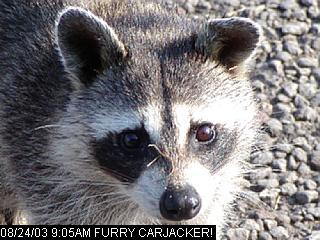 ------------
------------
NOT
A HAPPY TREE FRIEND
If you'd like to know
more about the park follow these links:
Brazos
Bend
State Park The main
page.
Brazos
Bend
State Park Volunteer's Page The
volunteer's
main page.
Go
back to my home page, Welcome
to rickubis.com
Go
back
to the RICKUBISCAM
page.
Go
back
to the See the
World
page.




































































































 -
- -
- -
- -
- -
- -
- -
- -
-




 -
-










